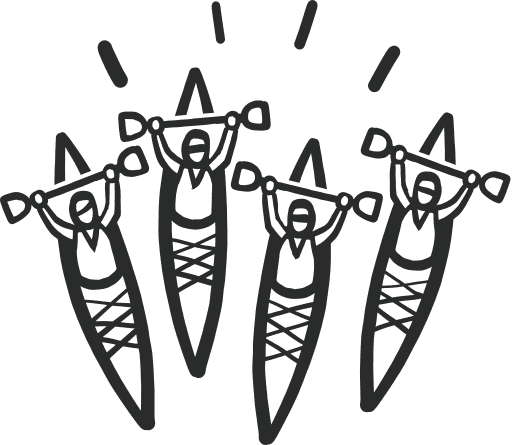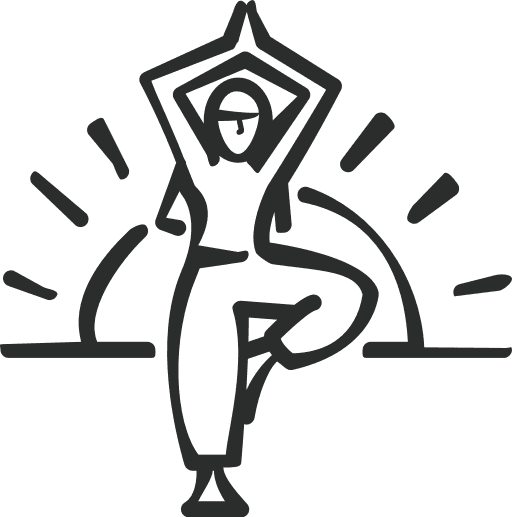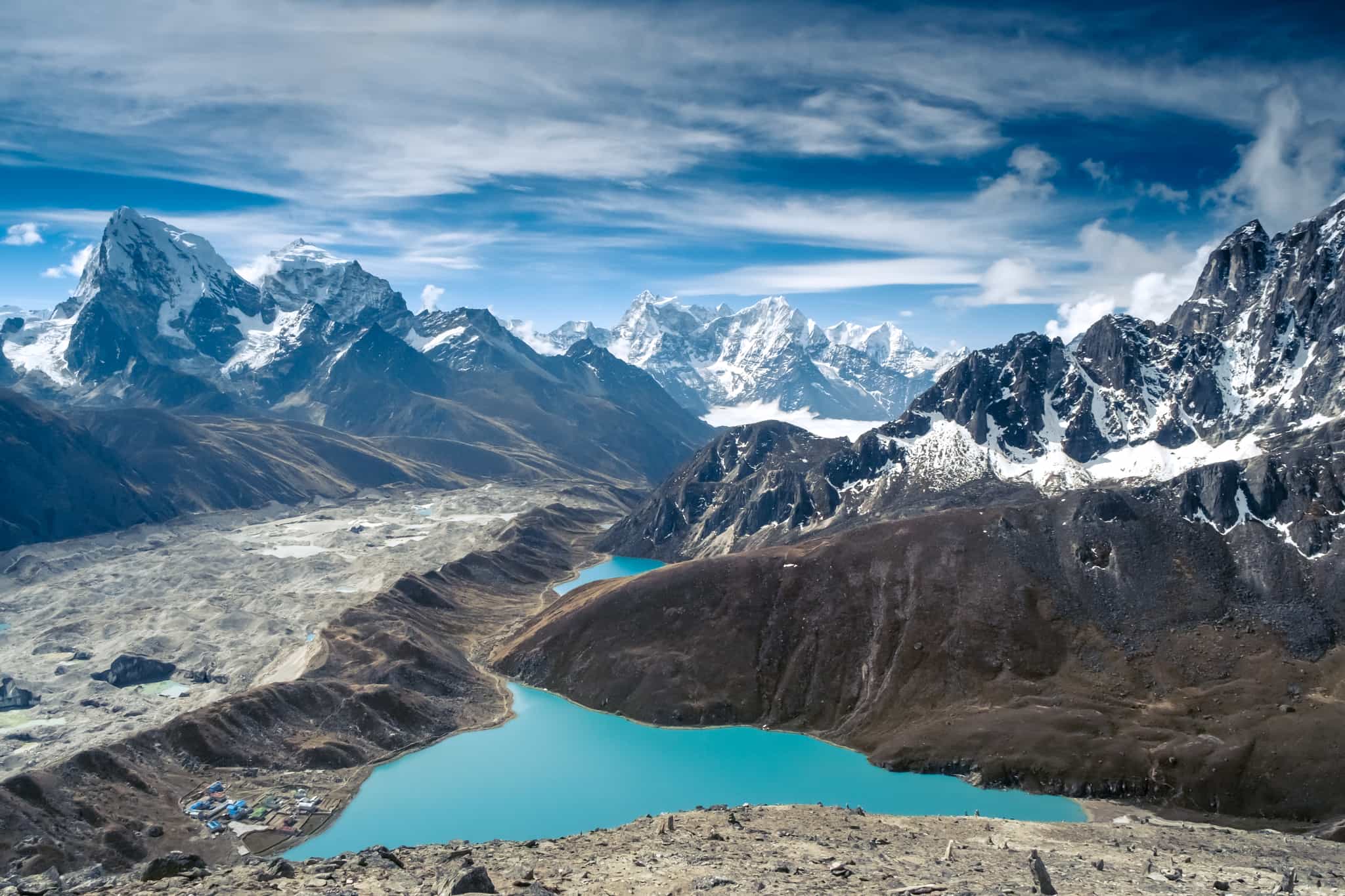
Everest and Gokyo Lakes Circuit
Hike through rugged terrain and traverse the mighty Cho La Pass as you climb to Everest Base Camp the hard way
What's Included?
Activities & Certified Guides
All itinerary activities with local, expert, English-speaking guidesAll accommodation
2 nights in a hotel, 1 night glamping and 15 nights in Nepalese teahousesMeals
2 breakfasts plus welcome and farewell dinners in KathmanduInternal flights & Transfers
Return flights between Kathmandu or Manthali and Lukla; transfers to and from Kathmandu Airport; all local transfersPorterage & Permits
Transportation of your overnight luggage, plus all trekking permits and feesSmall Like-minded Groups
Solo-friendly by design, join our small n’ sociable groups of up to 14 like-minded, active and outdoorsy people…
…
What's it like?


















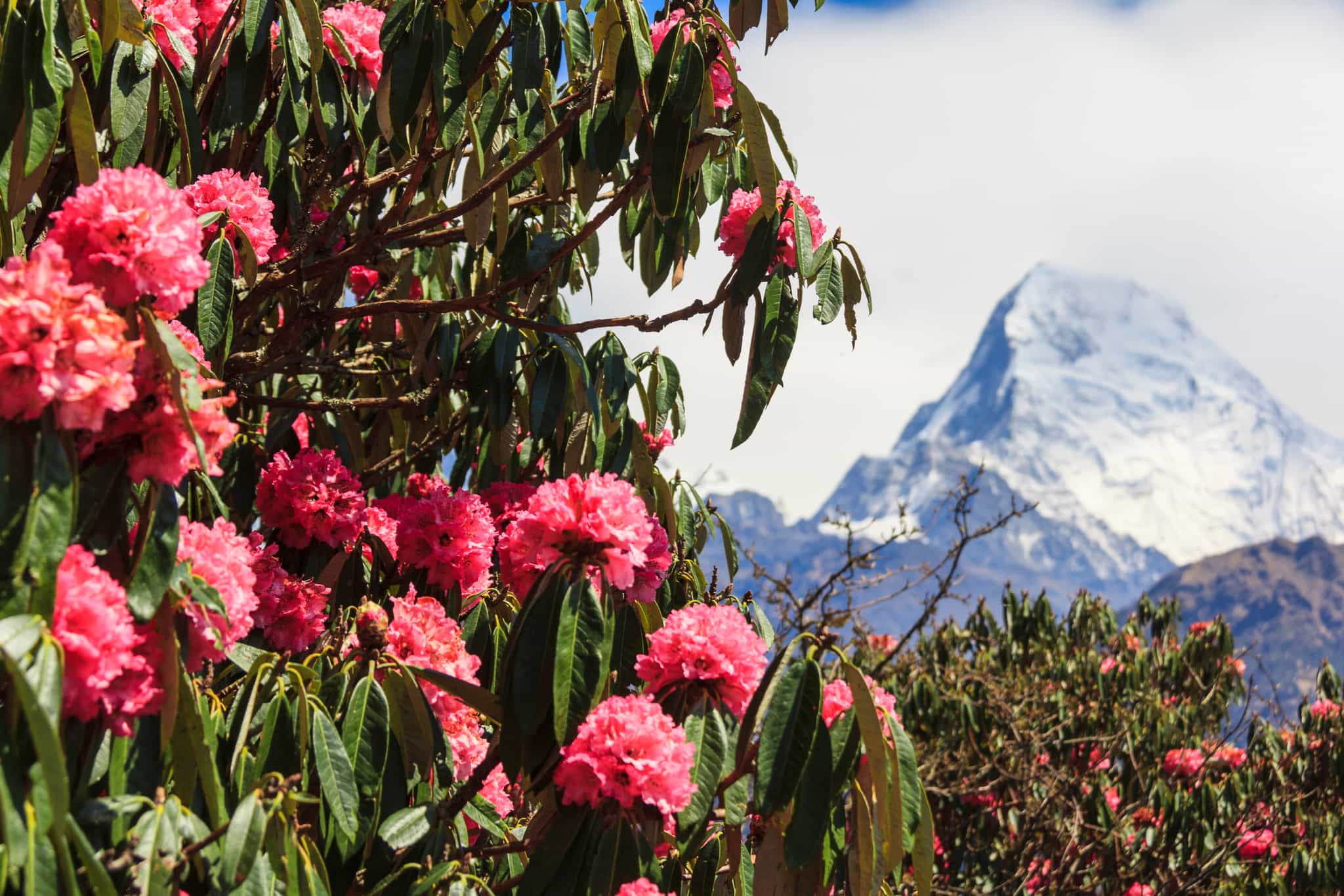
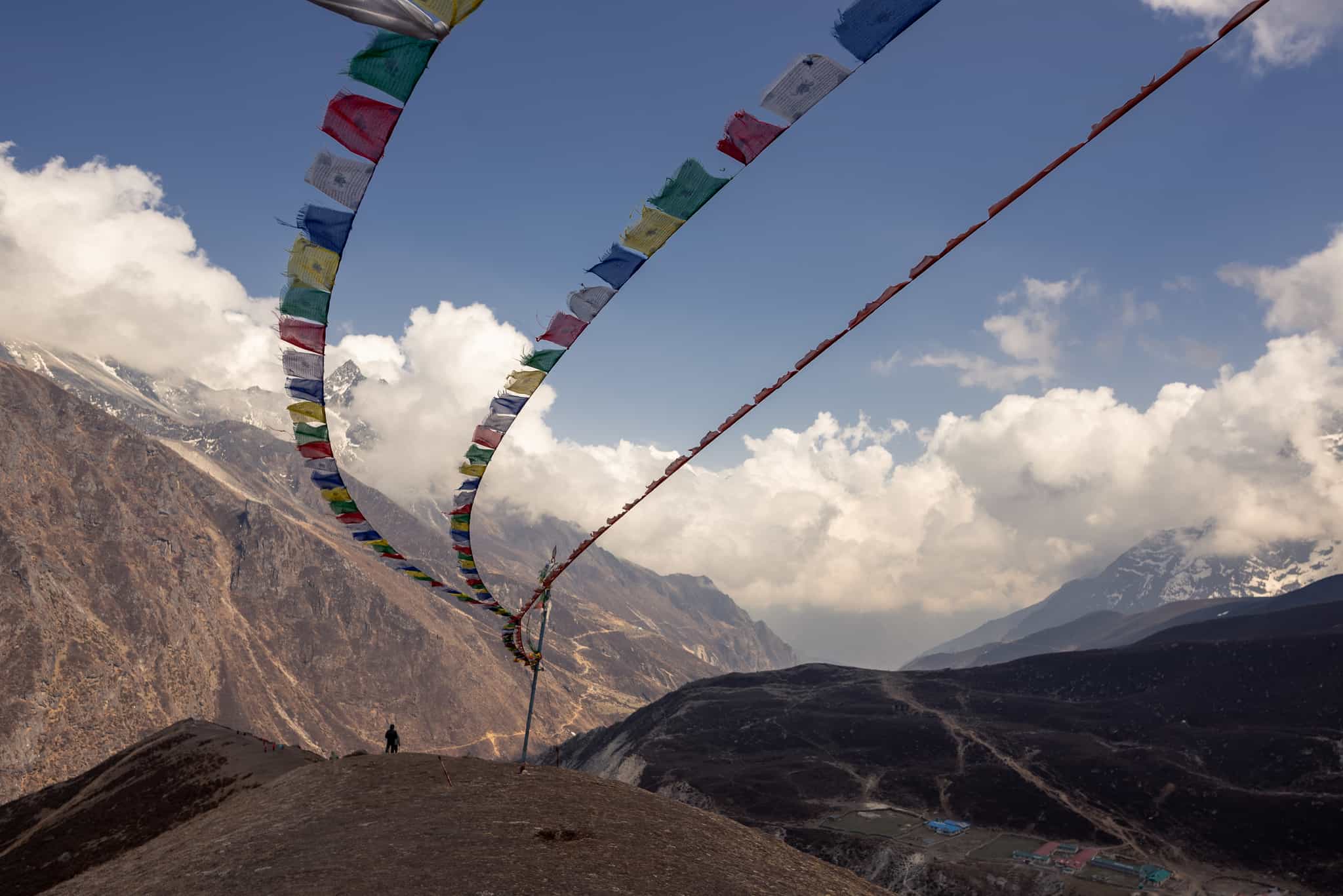
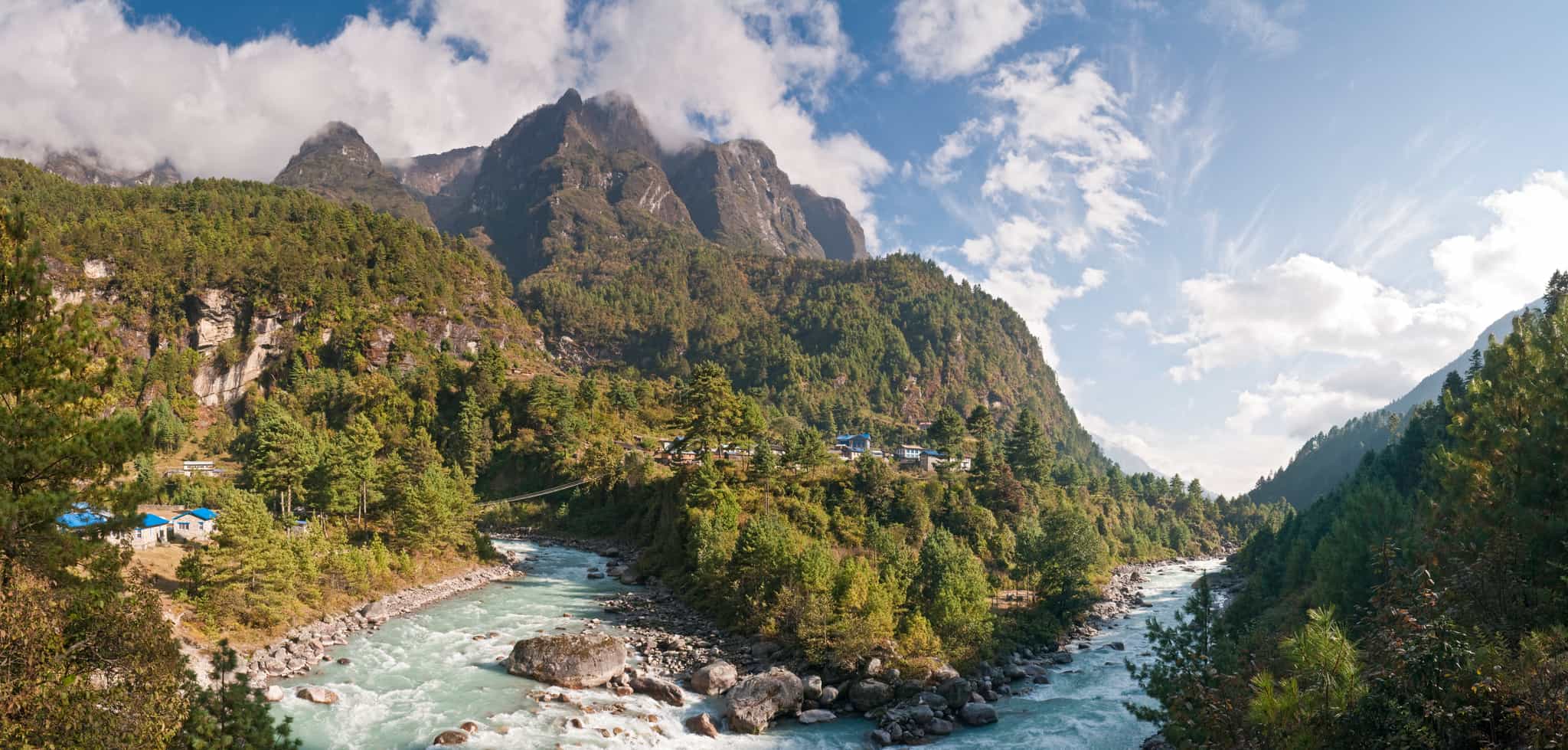
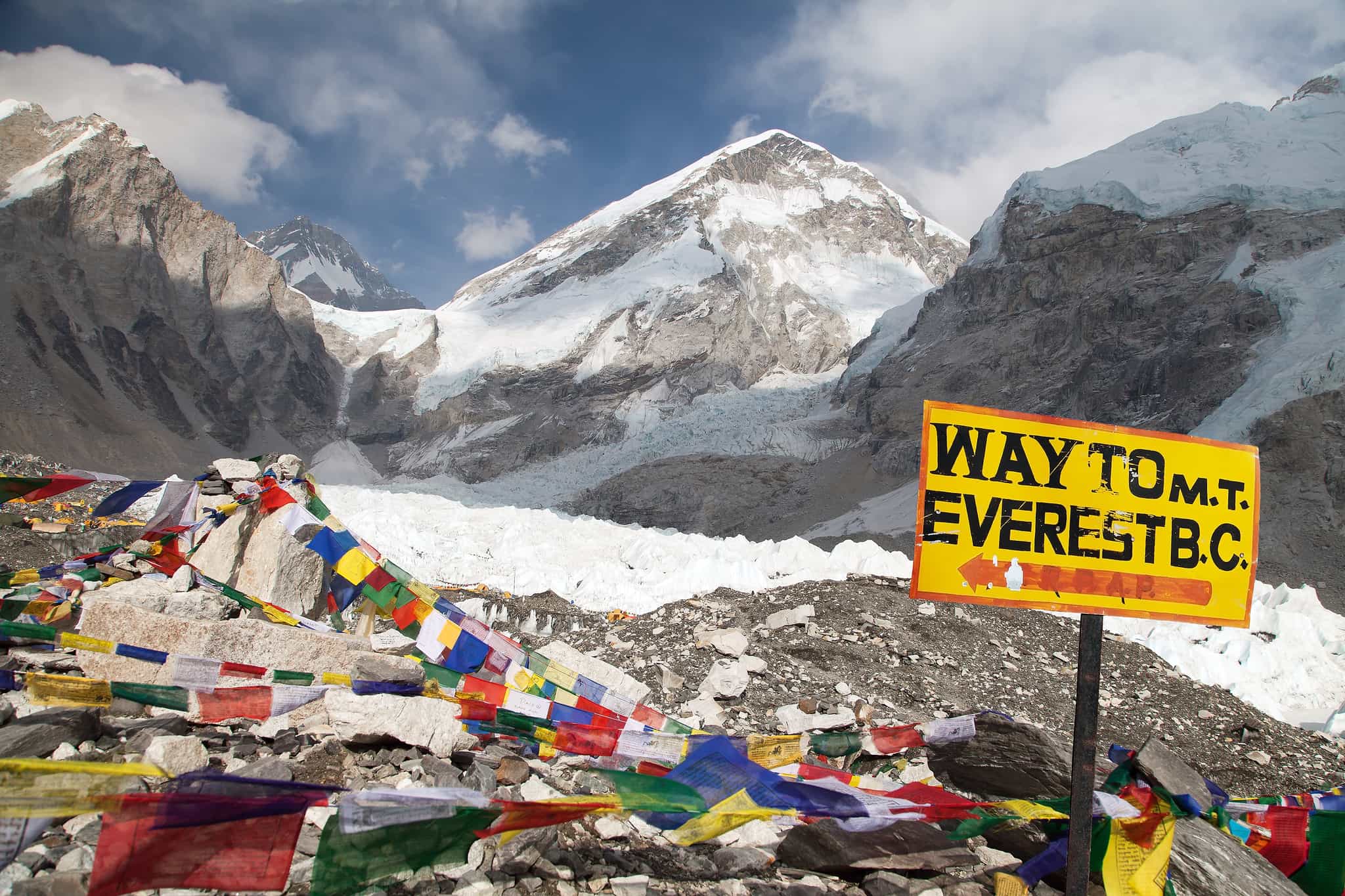
Stand at the foot of the highest mountain in the world on this challenging circular trek through the quiet and relatively untrodden Gokyo Valley
Snake between cairns, ice and moraine as you trek the famous Ngozumpa Glacier - the longest in the Himalayas - to reach the top of Cho La Pass (5420m)
Ascend Kala Patthar (5550m) and Gokyo Ri (5357m) for some of the best views in the Himalayas, including Everest’s summit and the turquoise Gokyo Lakes
Unsure which trek in the Everest region is for you? Check out our handy guide comparing this route with the classic Everest Base Camp trek
Key Information
Day 1
Intoxicating Kathmandu
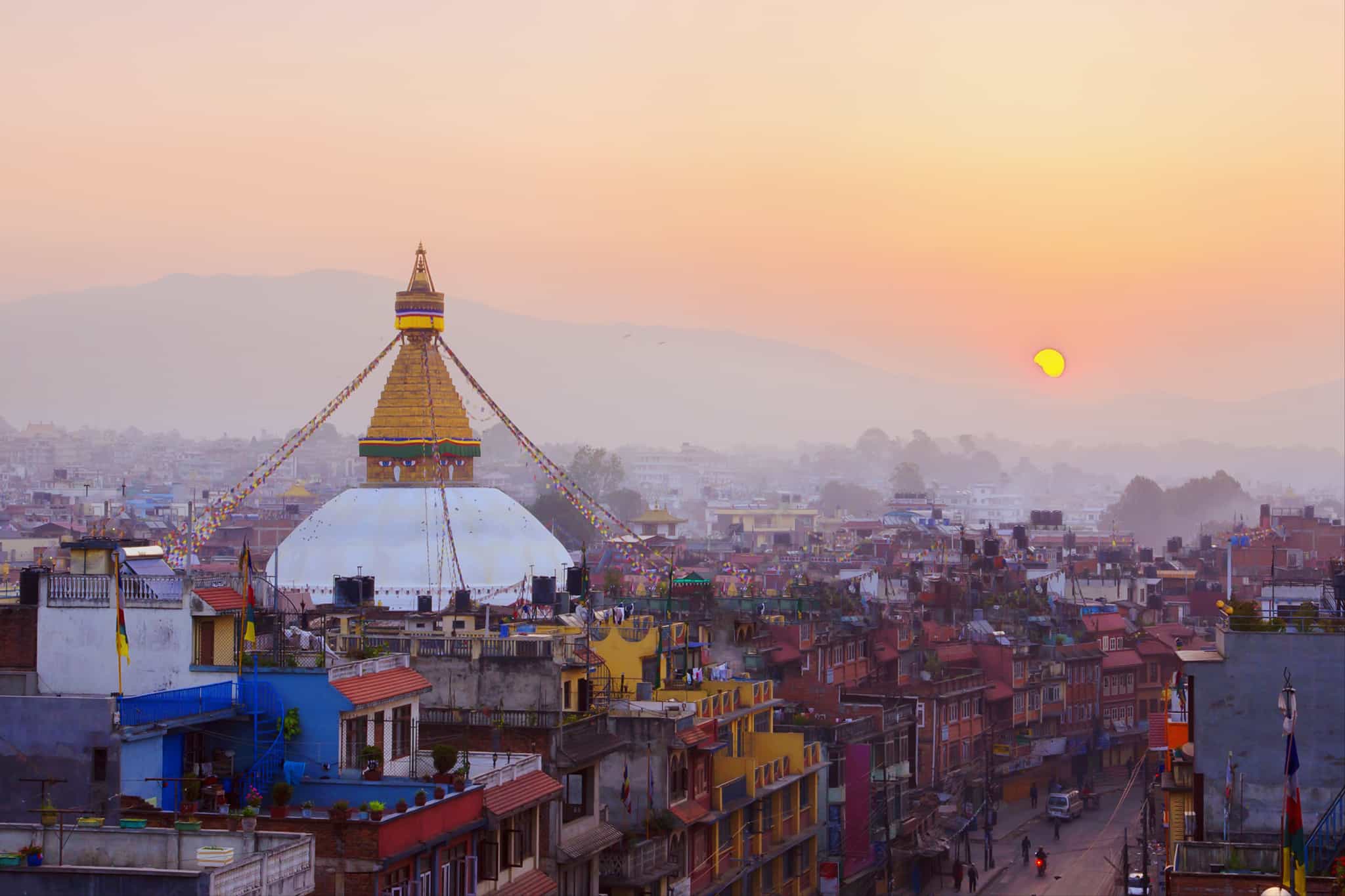
Check into your hotel in Thamel and get your first taste of life in Kathmandu. After meeting your guides and making any last minute plans for the trek, you’ll finish the day with a group dinner alongside the rest of your team.
Day 2
Journey to Manthali
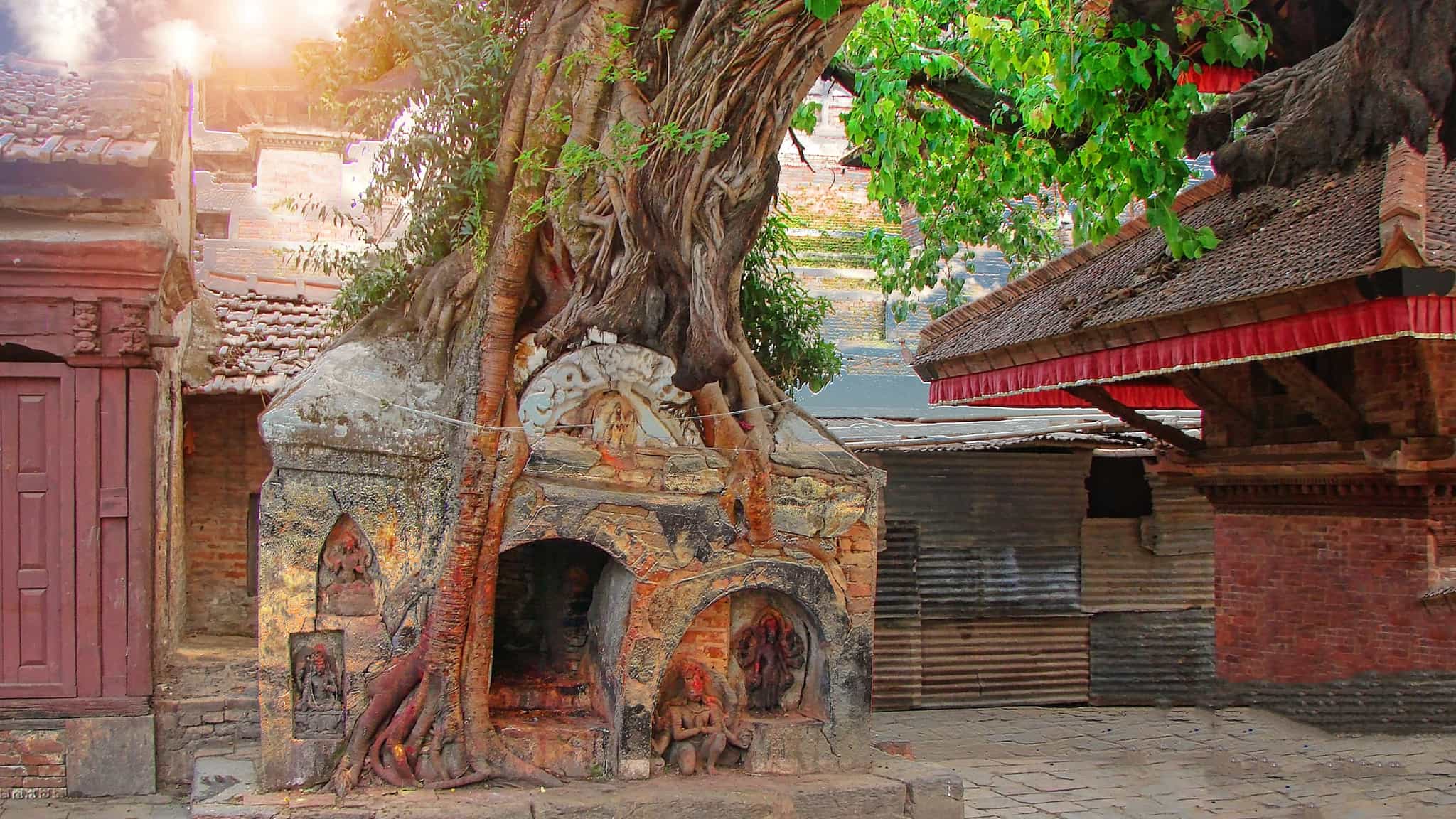
Driving
Head out of the city as you jump on the bus to Manthali. This remote region is where most Lukla flights now depart from (although occasionally they depart from Kathmandu if you're lucky) and you'll spend the night in safari tents near to the small airport so you're ready to jump on the first flight in the morning.
Day 3
Fly to Lukla, trek to Phakding

Hiking
Fly across the roof of the world on a small plane to Lukla in the Everest region – a breath-taking (and occasionally thrilling) journey and the jumping-off point for your trek. Meet the rest of your local crew and then hike along the lovely Dudh Kosi River to Phakding village where you'll stay in your first teahouse.
Occasionally Lukla flights can be delayed or cancelled - please see the FAQs for further information.
Day 4
Phakding to Namche
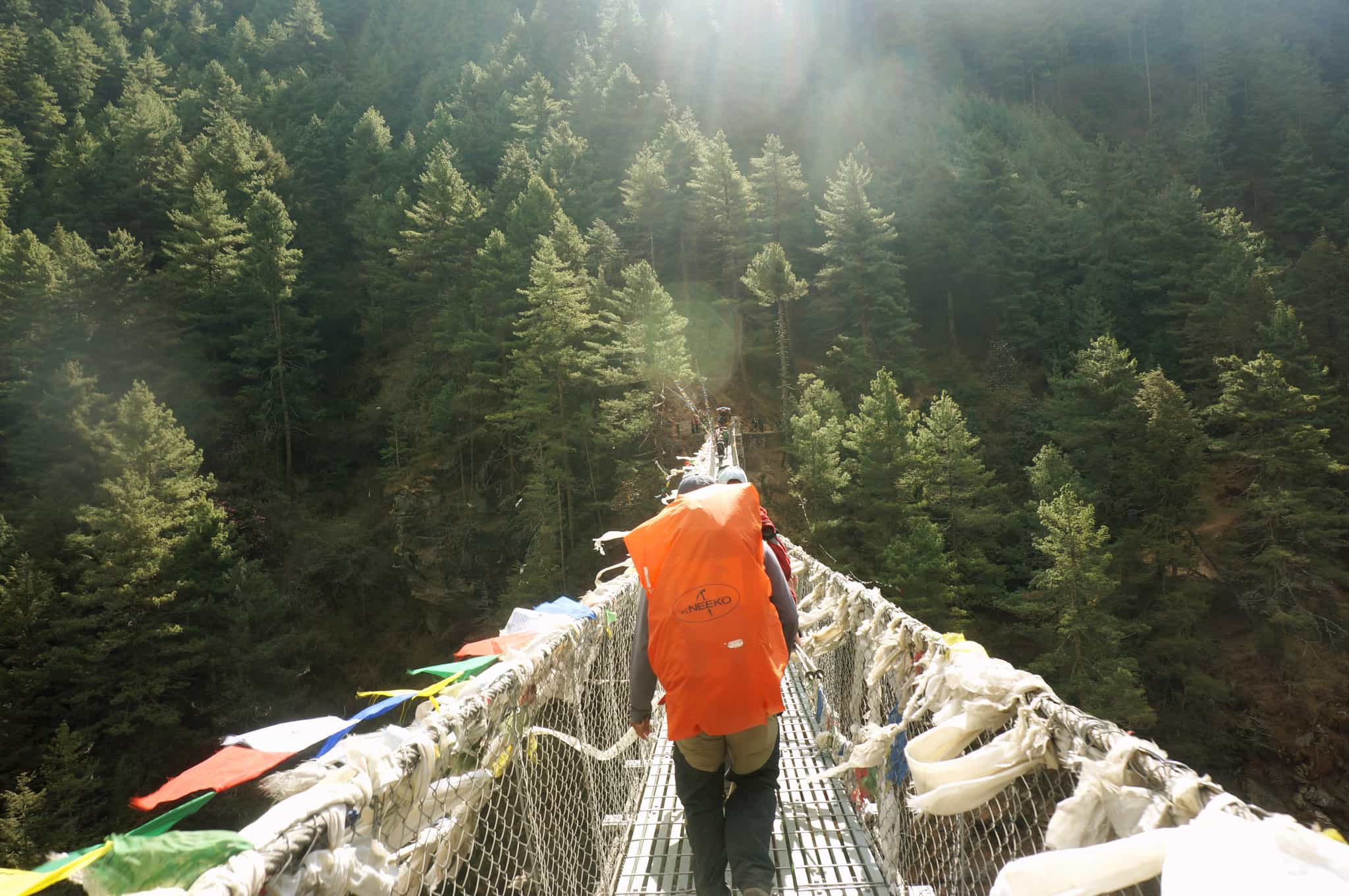
Hiking
Start your day with a walk through a beautiful pine forest and then cross the famous Hillary Suspension Bridge – be sure to check out the wonderful view of Mt. Thamserku (6618m) in the distance. Continue on to Jorsale village and up the challenging climb to Namche Bazaar where you’ll get your first glimpse of the world’s highest mountain, the immense 8,848m peak of Mount Everest.
Day 5
Acclimatise and explore Namche
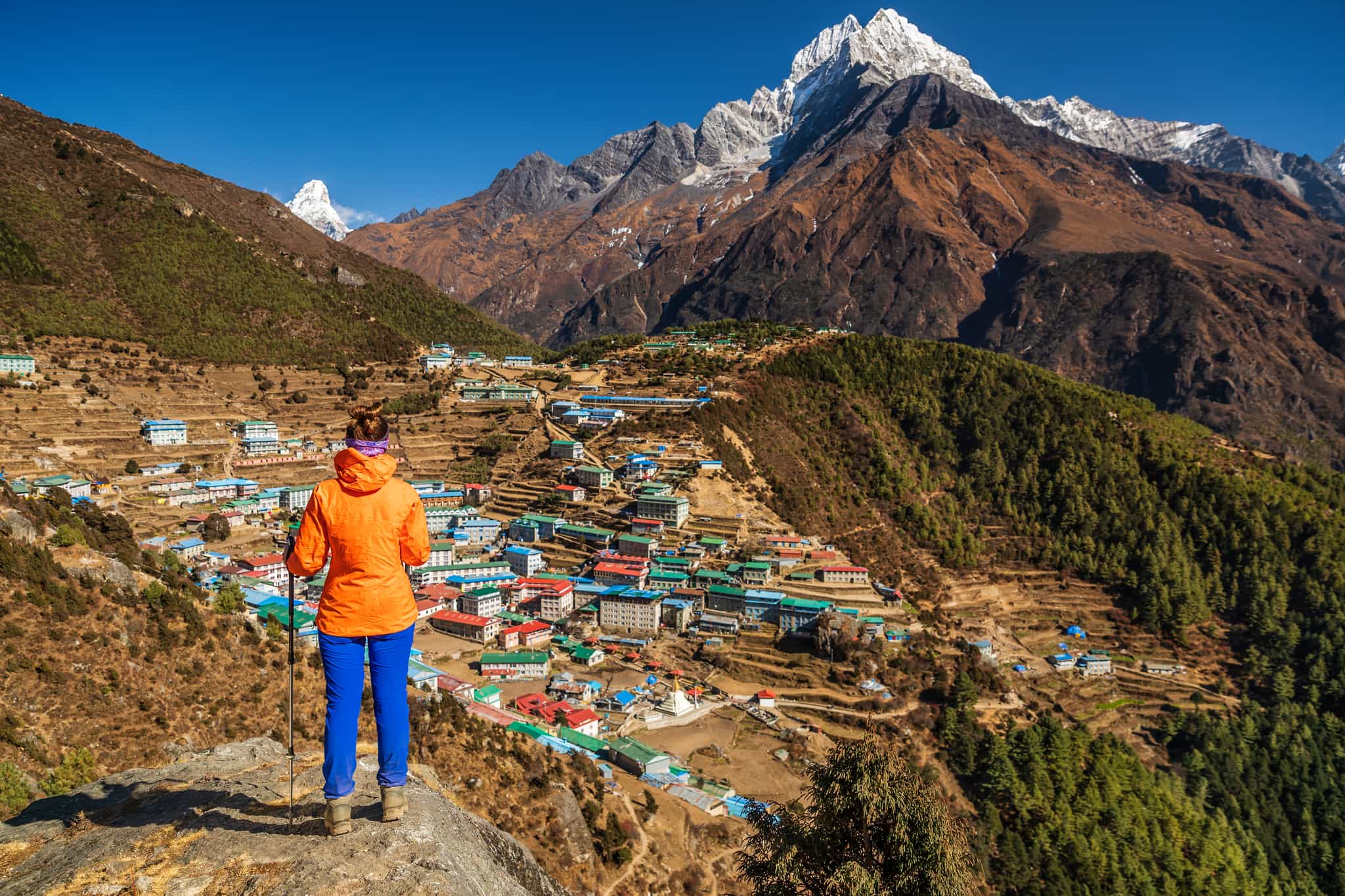
You've now reached 3440m, so it's time to spend the day acclimatising to the altitude. Relax, wander the village, visit the Hillary School and Khunde Hospital, or hike to a nearby viewpoint where you can enjoy an incredible panorama of Mount Everest, Ama Dablam, Thamserku and Lhotse.
Day 6
Namche to Phortche Thanga
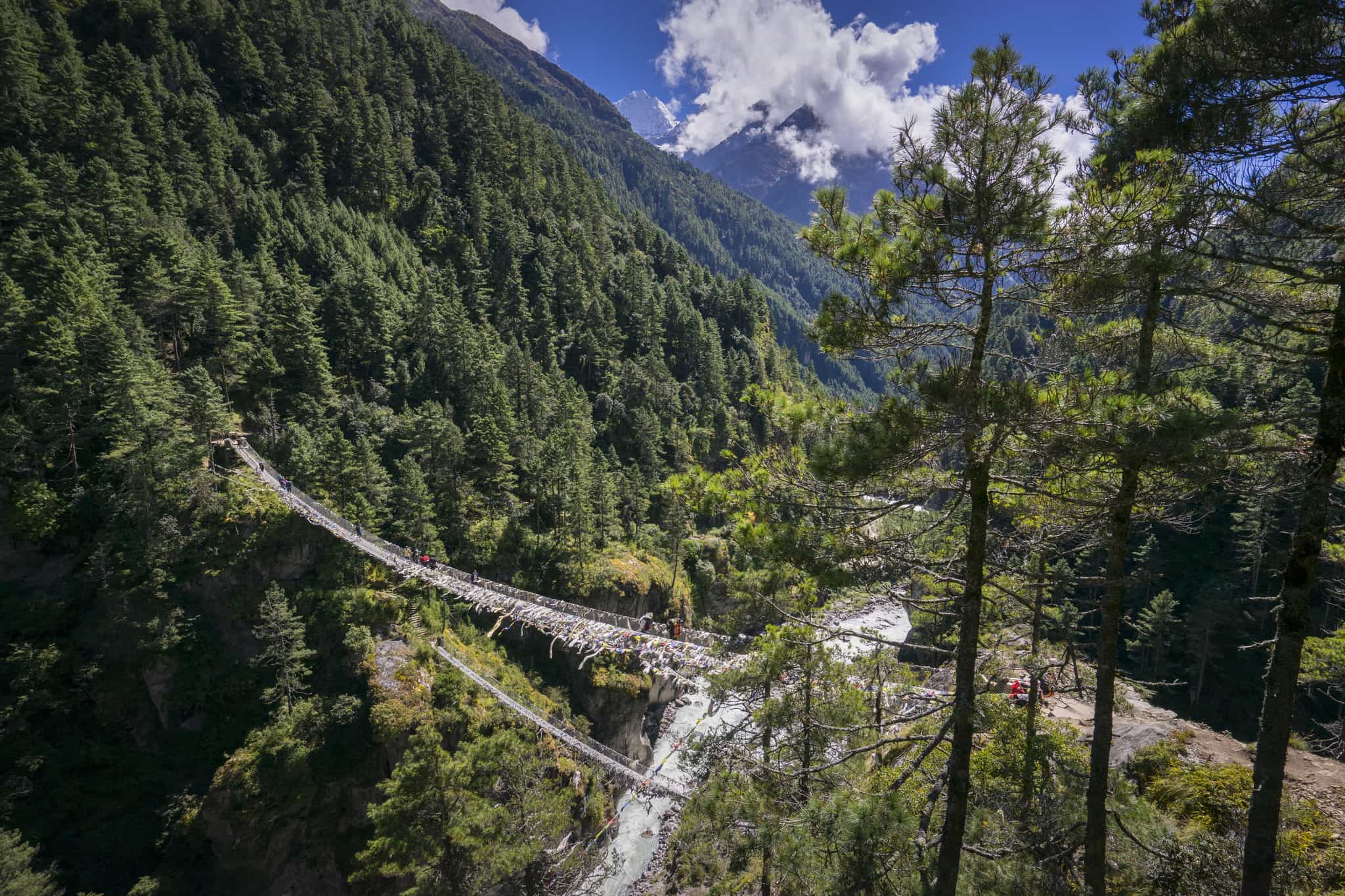
Hiking
Push above the 4000m line to the Mong La Pass with its amazing views of the Dudh Koshi River. Continue hiking to tonight’s destination, the village of Phortche Thanga where you can visit a local monastery or just eat and relax on the riverbank.
Day 7
Phortche Thanga to Dol
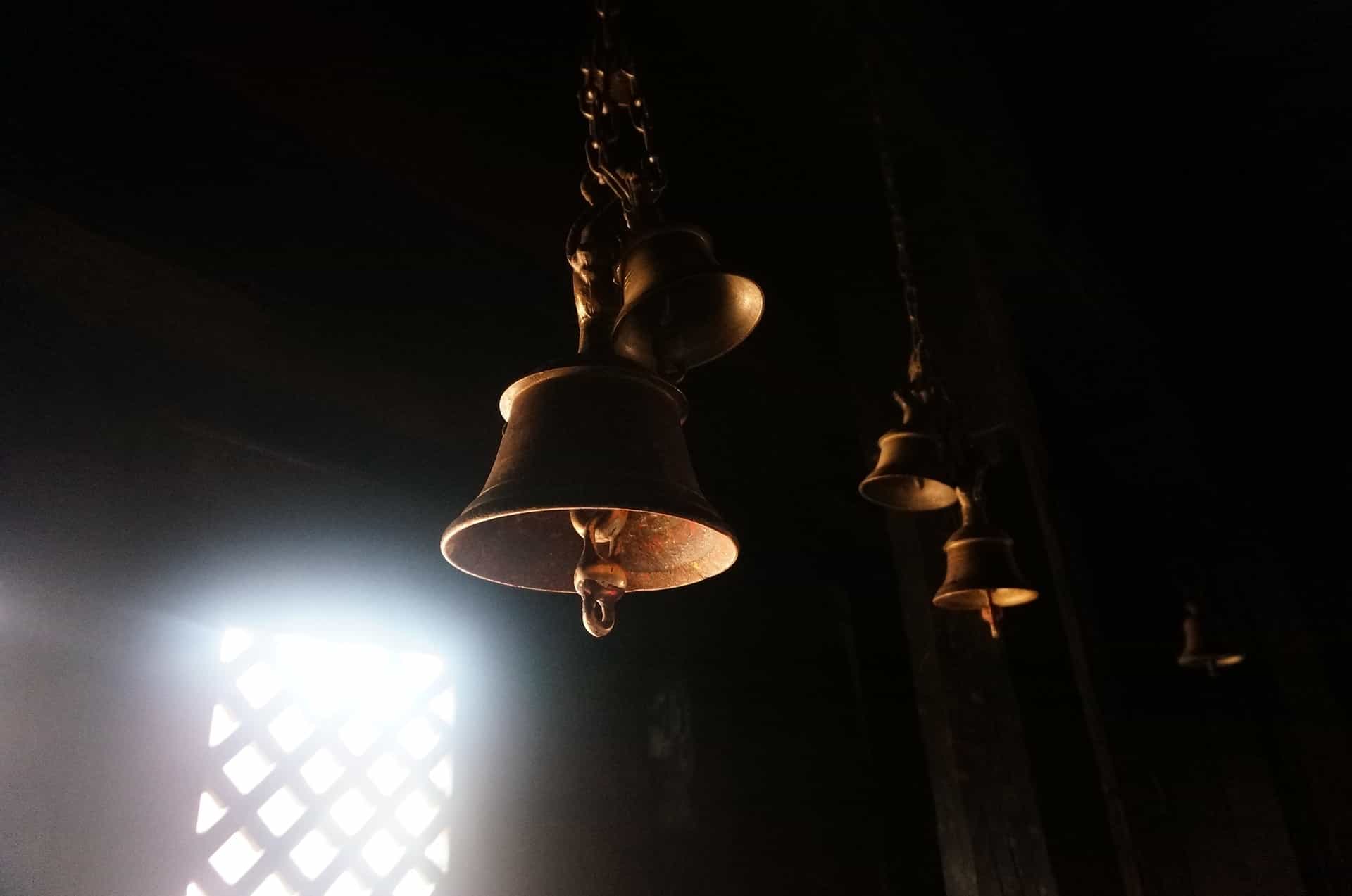
Hiking
Climb through the rhododendron forest and along a steep section to the Sherpa villages of Tonga and Gyele. Immerse yourselves in the local culture, capture some shots of the Khumbila and Tawache mountains and then get some rest ready for a big day tomorrow.
Day 8
Machhermo

Hiking
Ascend higher and higher through the jungle until it gives way to juniper forests, interspersed with yak pastures and summer camping grounds. Arrive at Machhermo around lunchtime and explore the valley with its amazing view of the 8,201m peak of Cho Oyu - the Turquoise Goddess.
Day 9
Enter the Gokyo Valley

Hiking
Begin your day with an epic view of the plunging Khantega Gorge and then follow the river as it winds its way toward the vast, 36km Ngozumpa Glacier – the longest in the Himalayas. From here its time to enter the Gokyo Valley, one of the most picture-perfect locations on earth, home to the highest freshwater lakes in the world, sacred to both Hindus and Buddhists.
Day 10
Acclimatise in the valley
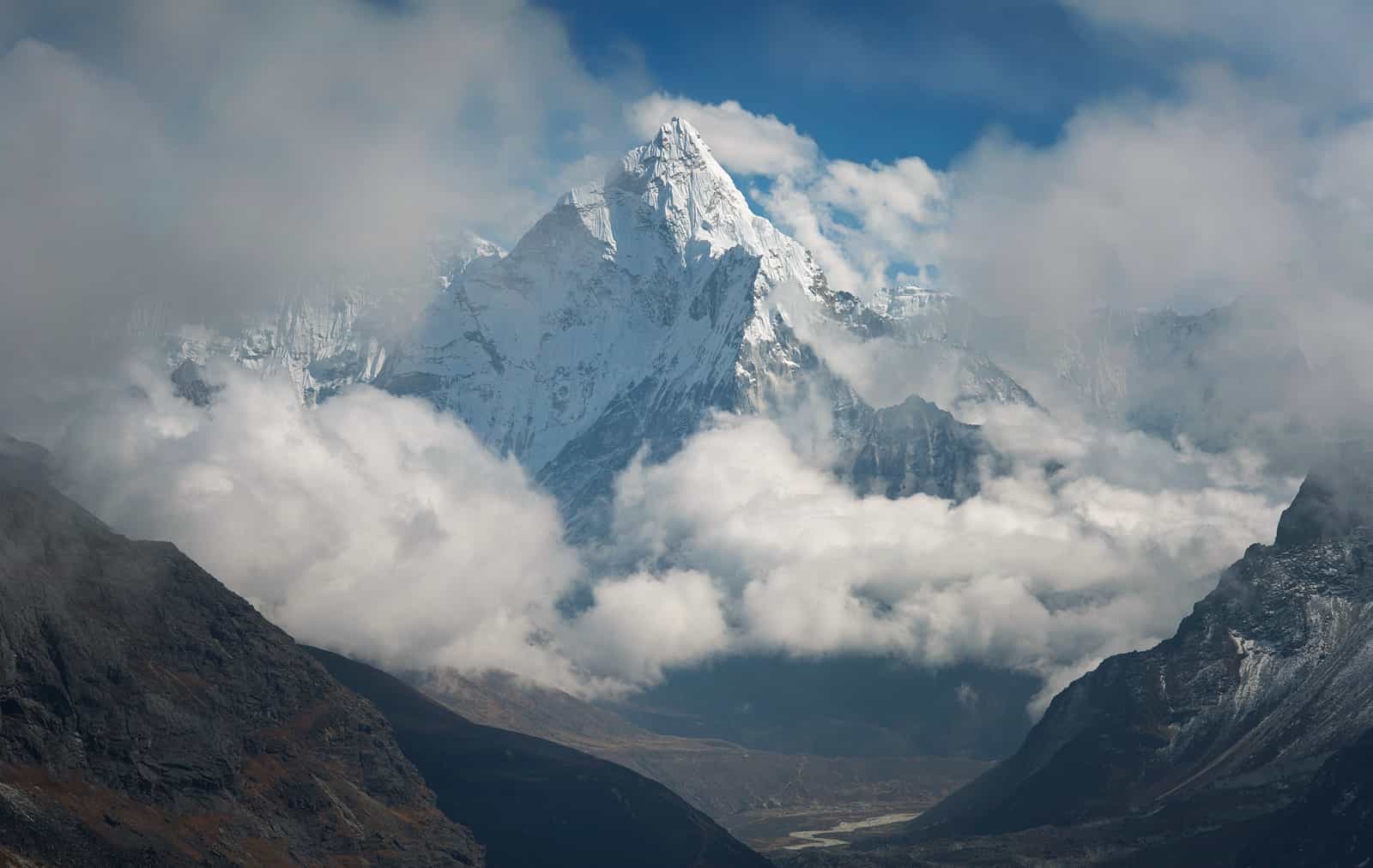
You’re now approaching 5,000m, so it's time to acclimatise once again as you prepare for the final push. Spend some time hiking this beautiful valley, and trek between glorious lakes fed by towering peaks. If you're feeling acclimatised, do not miss the opportunity to hike up the small peak of Gokyo Ri (5,360m), a viewpoint that has to be seen to be believed - the Ngozumpo Glacier stretches for miles, a string of lakes line the valley floor, and four of the highest peaks in the Himalaya are visible (including Everest) and the Gokyo Lakes themselves!
Day 11
Trek to Thagnak village
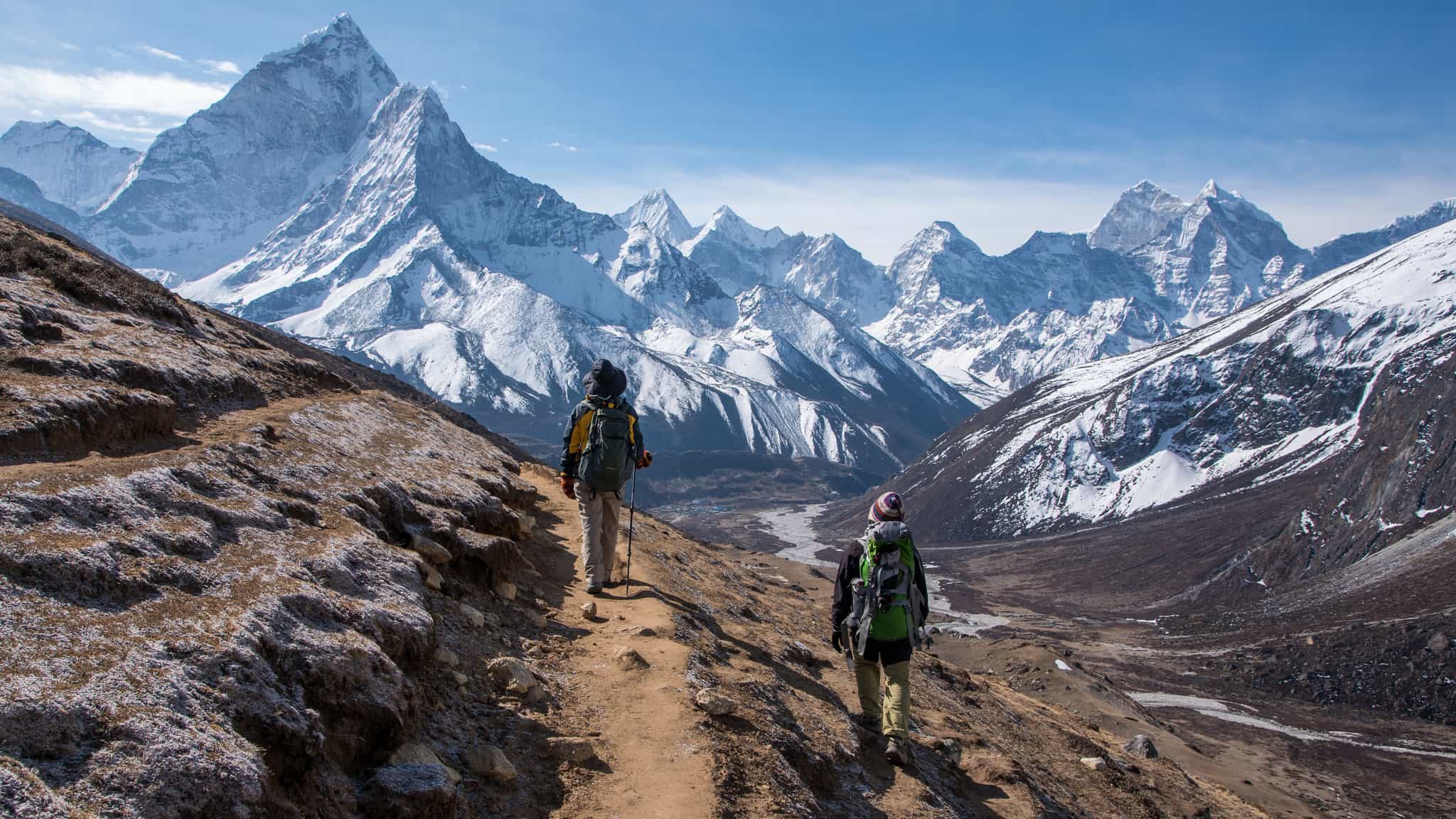
Hiking
Trek the short distance to the small, highland village of Thangnak. The trail from Gokyo climbs up and onto the mighty Ngozumpo Glacier and undulates its way across to the far side, snaking between cairns, ice and moraine deposits to reach Thangnak - staging point for the Cho La Pass. Relax, continue acclimatising and prepare for one of the best days hiking in the morning.
Day 12
The Cho La Pass
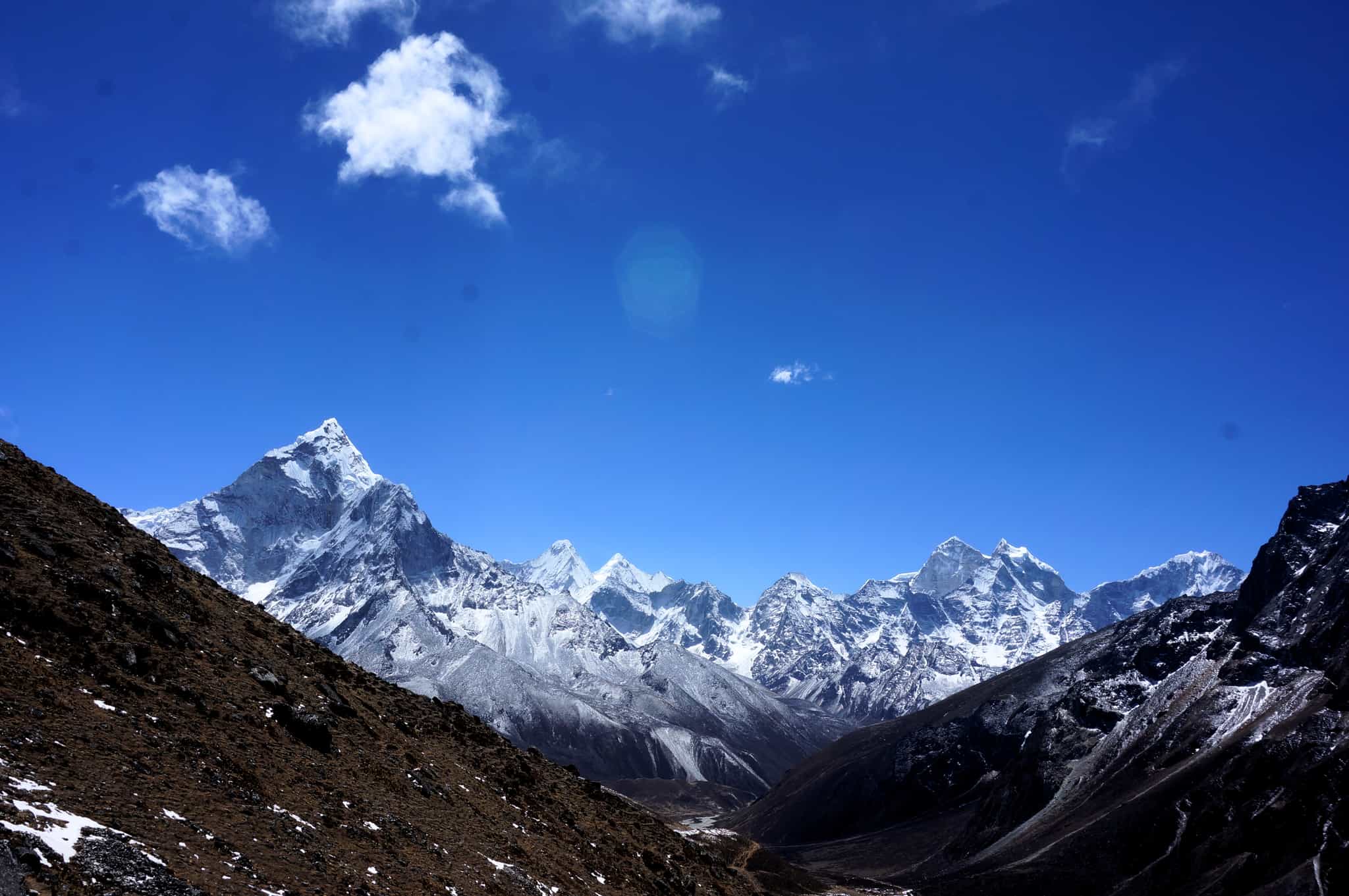
Hiking
Climb the steep, eastern side of the Cho La Pass before dropping down into the main Everest Valley. The ascent of the pass is steep and rocky and the upper part requires some scrambling (and is often covered in snow and ice). You'll definitely feel like you've earned the astonishing Himalayan panorama that waits at the top. The glaciated top is a bit easier-going before descending via a rocky gulley to the valley floor below. Continue on to Dhzongla village and rest up for the night.
Day 13
Dhzongla to Lobuche
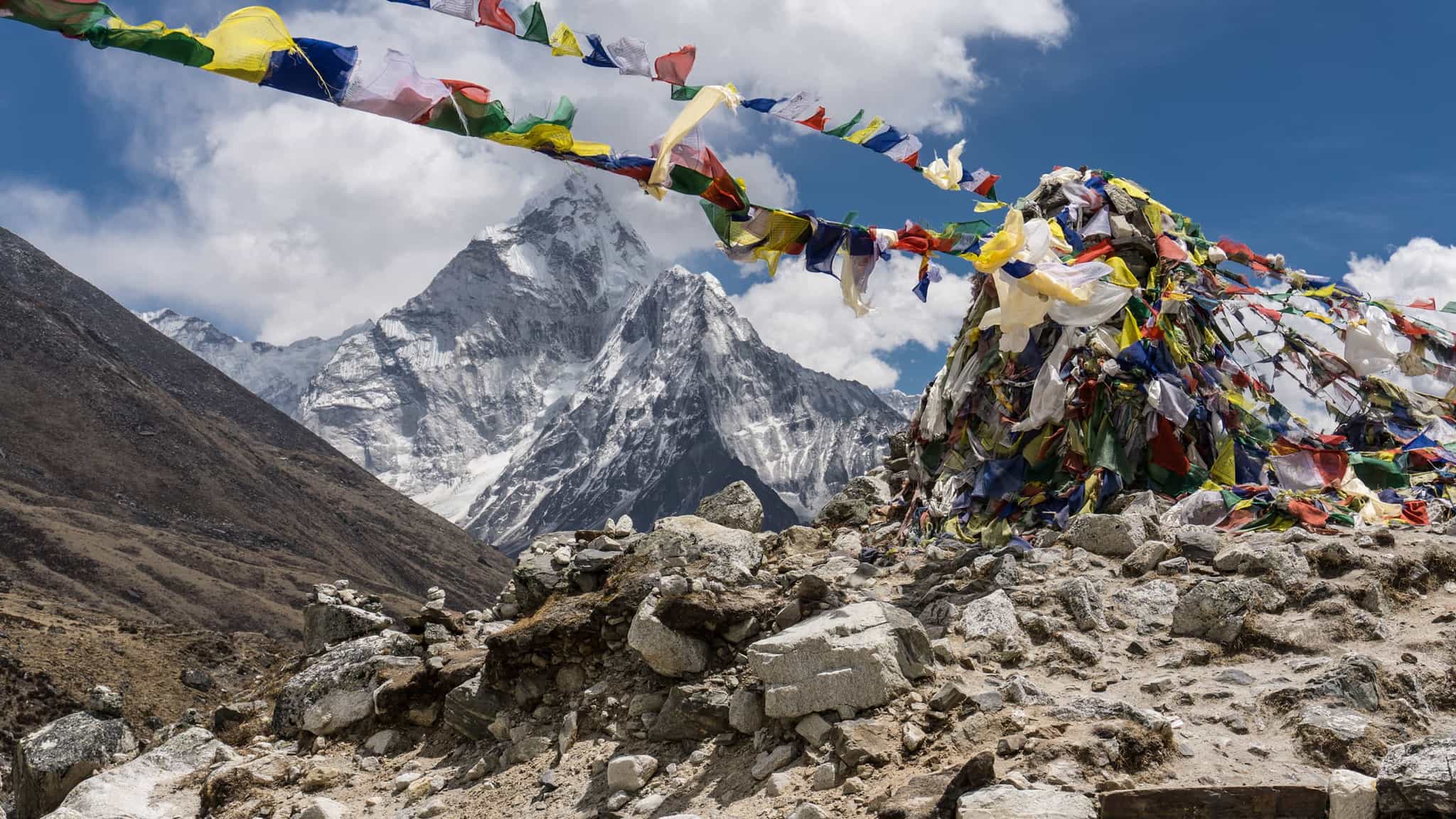
Hiking
Take a moment - your goal is within touching distance, so there’s plenty of time to rest up, recover and enjoy some high altitude scenery as you travel between mountain villages.
Day 14
Destination Everest Base Camp

Hiking
Navigate around the Khumbu Glacier and on to Everest Base Camp, sitting at a whopping 5364m. Spend some time enjoying your achievement and fill your camera with jaw-dropping photos.
Day 15
Sunrise from Kala Patthar
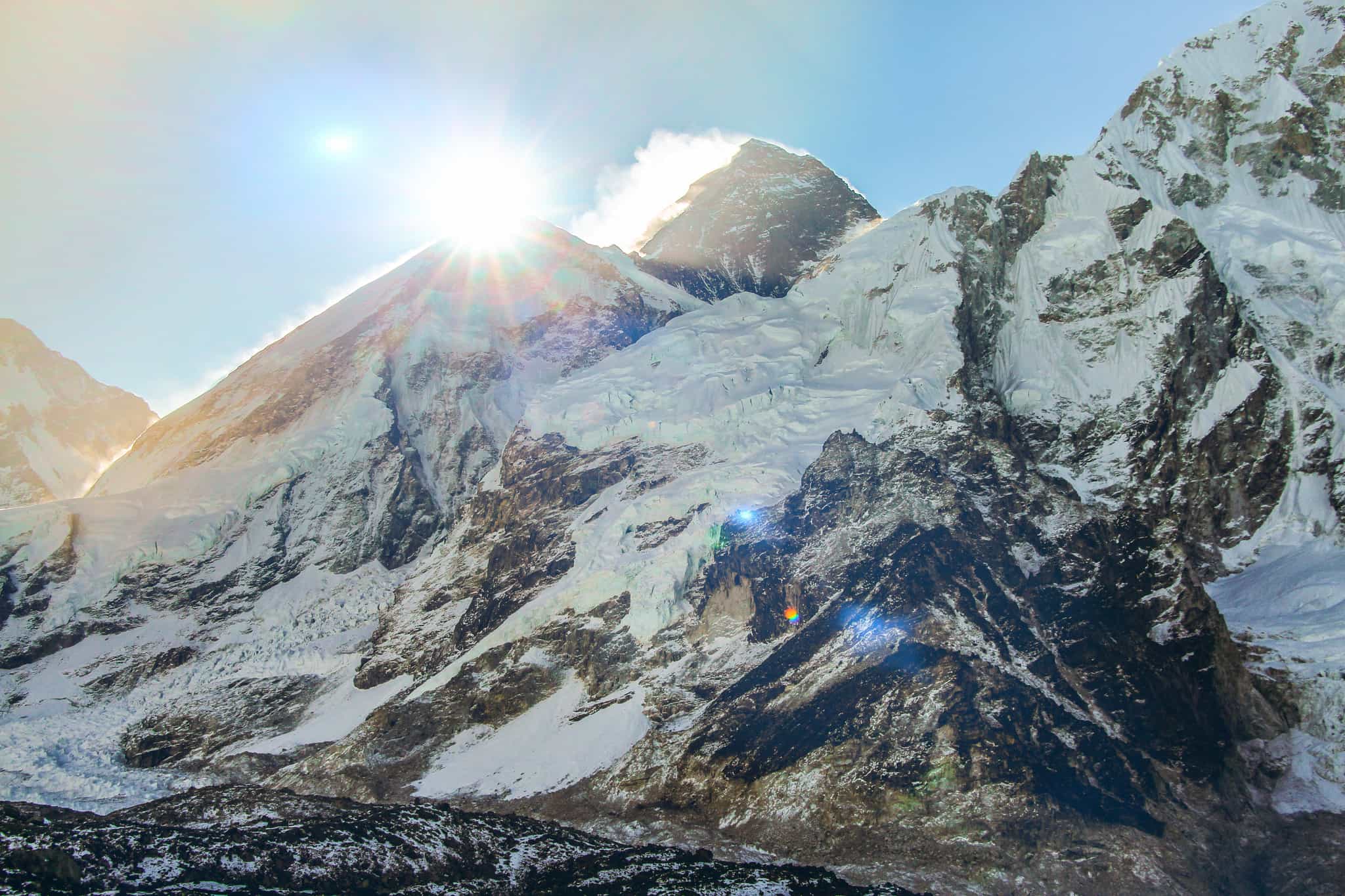
Hiking
Optional ascent of Kala Patthar (5,550m), the highest point of the trek, with a never-ending view of Everest and many of the other highest peaks on earth. After watching the sun rise from behind the mountains, return to Gorak Shep to refuel on breakfast before descending to Pangboche, where you’ll spend the night.
Day 16
Pangboche to Namche
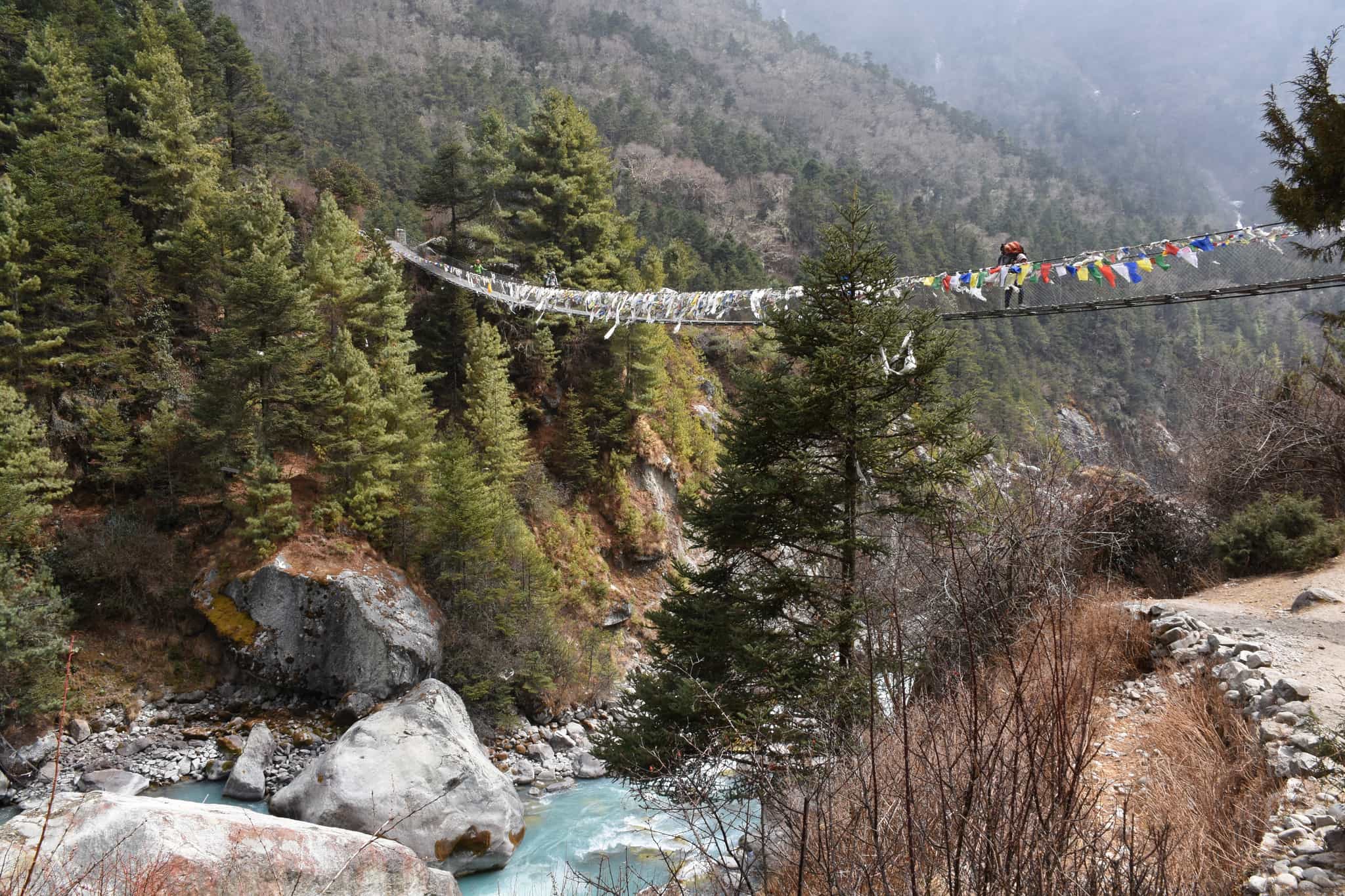
Hiking
Cross over suspension bridges and re-enter the jungle before tackling the steep incline that leads to Phungi Than. Continue through the forest and back to Namche.
Day 17
Begin the final descent

Hiking
Trek through the pine and rhododendron forests one last time before saying goodbye to your local support staff and heading back to Lukla.
Day 18
Return to Kathmandu
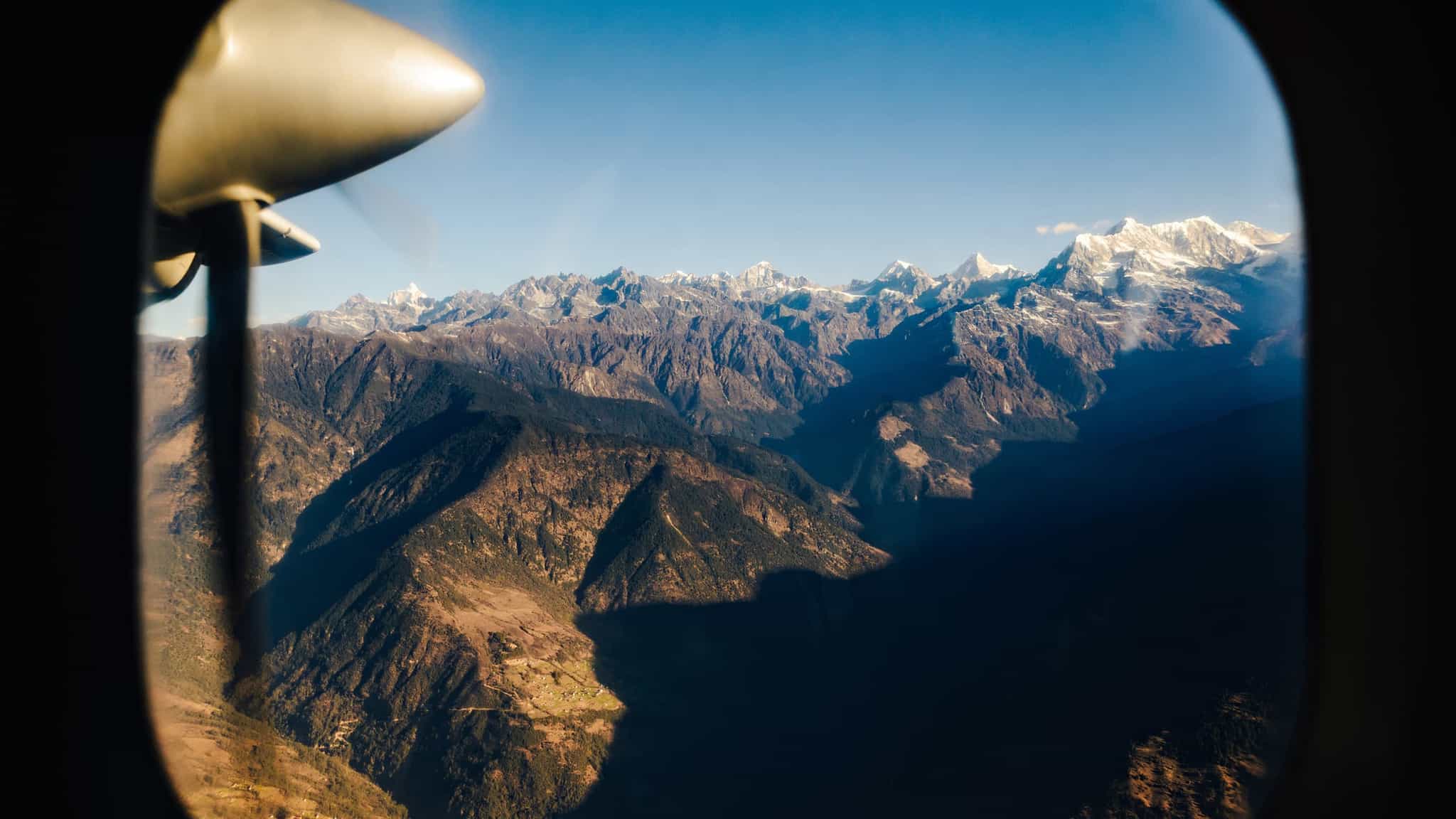
Driving
Fly back to Ramechhap (Manthali) after your incredible mountain journey. You'll drive back to Kathmandu in time for some well-earned beers and a celebration dinner.
Day 19
Last chance to enjoy Nepal
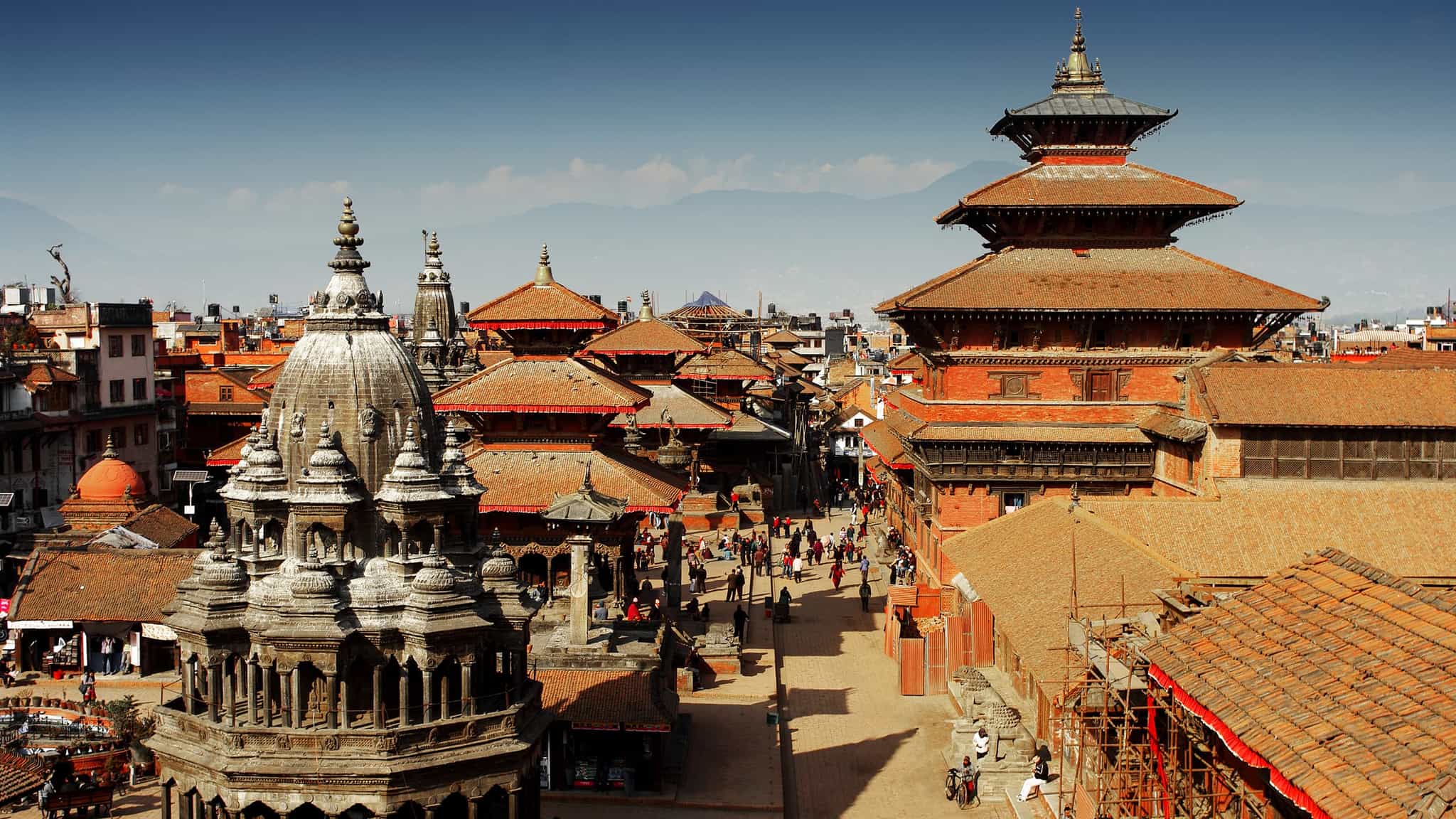
Sleep in, have breakfast in your hotel and then spend some final time in Kathmandu before returning to the airport and back to reality.
The Area
Logistics
Starts
Tribhuvan International Airport, Kathmandu
Anytime on Day 1
Ends
Tribhuvan International Airport, Kathmandu
Anytime on Day 19
Transfers
Airport arrival and departure transfers are included no matter when you arrive and depart (even if booking extra nights before or after the trip), provided you have completed your passenger information form and have supplied your flight details in advance.
Travel options
There are regular flights to Kathmandu from major airports across the UK and Europe.
Day 1
Breakfast
Lunch
Dinner
Day 2
Breakfast
Lunch
Dinner
Day 3 – Day 17
Breakfast
Lunch
Dinner
Day 18
Breakfast
Lunch
Dinner
Day 19
Breakfast
Lunch
Dinner
What is the food like?
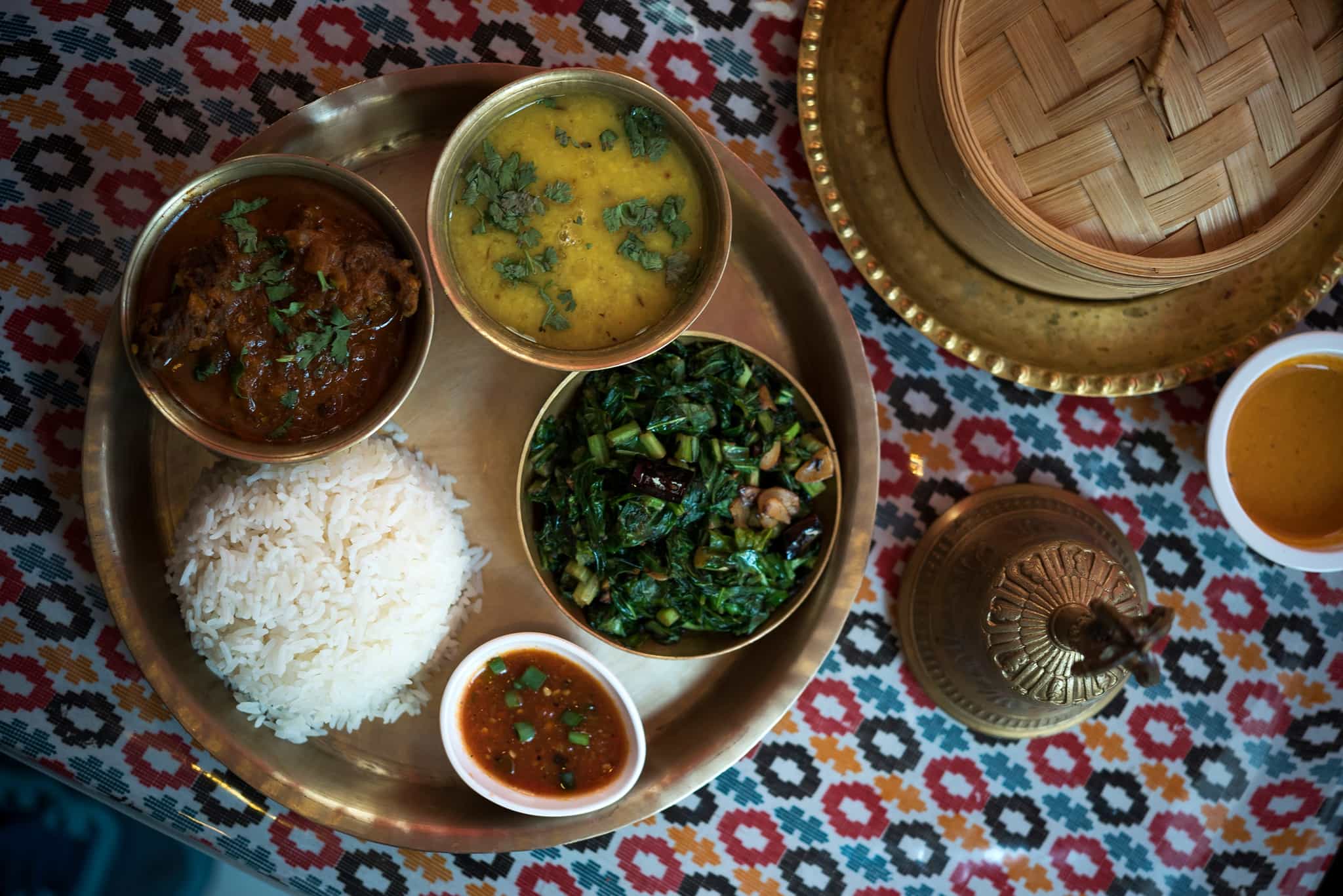
Breakfast is usually hot porridge, muesli or Tibetan bread served with an omelette or boiled eggs. Menus in teahouses are very similar at every stop and there will usually be a choice of traditional Nepalese dhal bhat (a mixed plate of lentils, rice, vegetables and pickles - delicious and healthy), Nepalese dumplings (momos), mixed noodles, pasta and even pizza. Although meat is available at some teahouses, we suggest you ask your guide for advice regarding its consumption, as it tends to depend on how far it has travelled as to whether or not it is a safe option.
Dairy-free, vegan or vegetarian diets can be catered for while trekking although meals may get a bit repetitive - dhal bhat will likely be your go-to staple. Gluten-free/coeliac diets are tricky to cater for on teahouse treks (beware that powdered soups and seasonings used often contain gluten, and cooking oil is commonly reused and may cause cross-contamination). Please explain your dietary requirements to your guide so that they can assist when ordering, and bringing along some extra food/snacks is advisable.
What is the accommodation like?
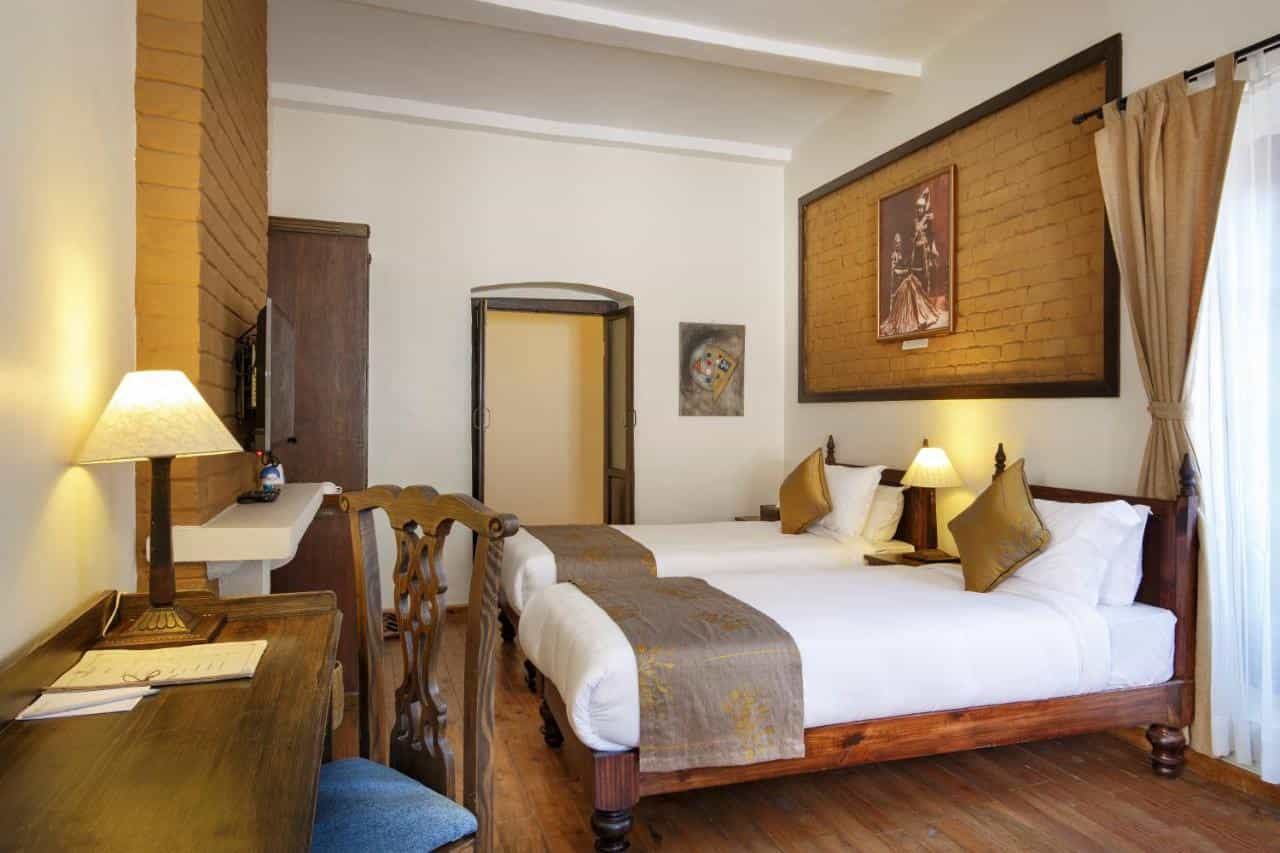
Kathmandu
You’ll stay in a hotel in Thamel close to the main shopping area and heritage sites. Expect an en-suite room with air-con and WiFi included.
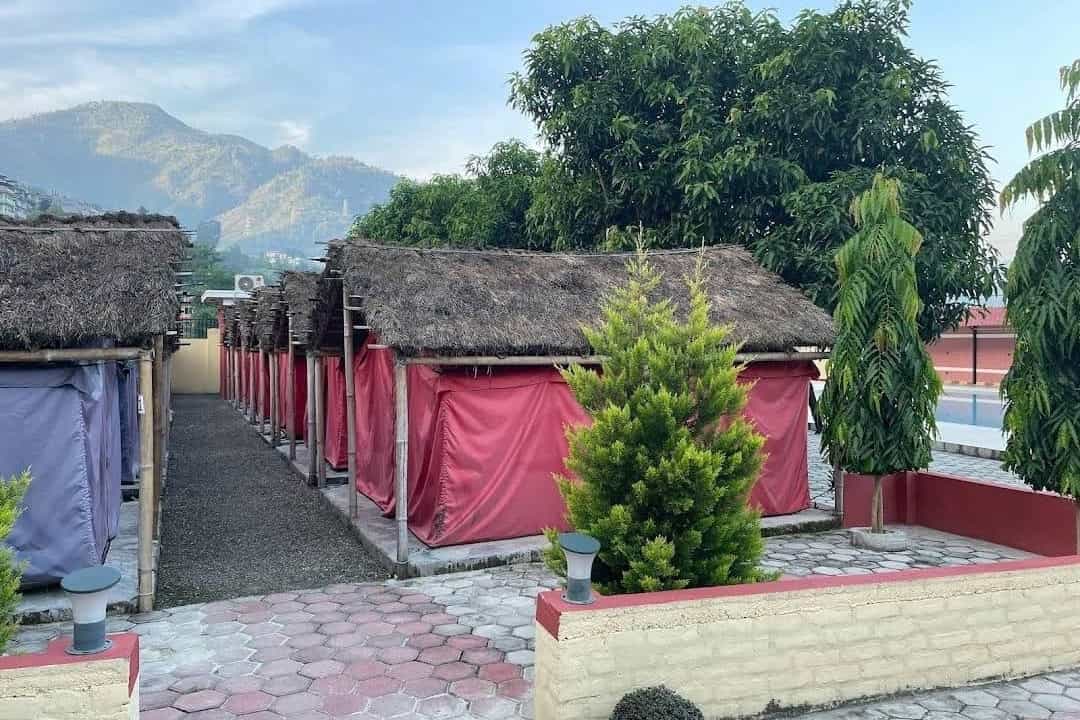
Manthali
For your night in Manthali, you will stay in safari-style tents at the Freedom Resort Fixed Tent Camp. The permanent tents are comfortably set with wooden floors and you will share on a twin-basis with shared bathrooms. There is a swimming pool, restaurant and bar on site.
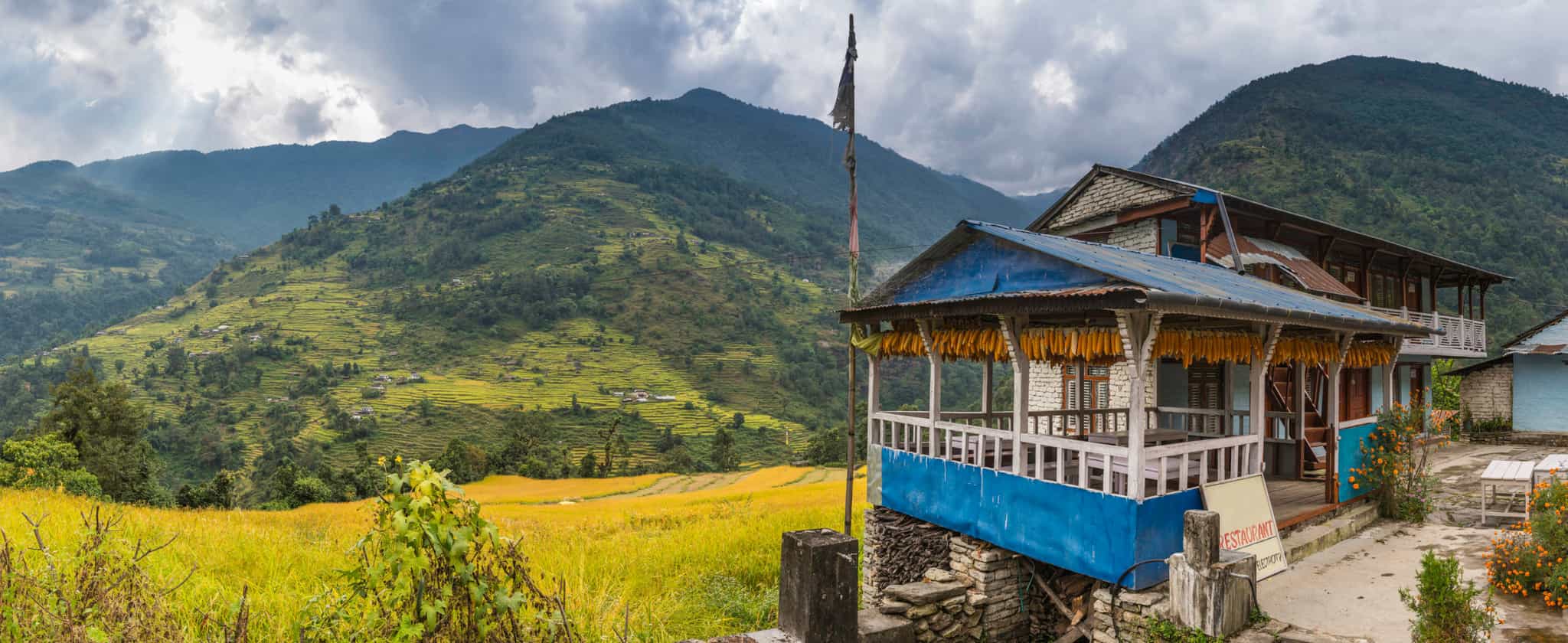
On the trek
You’ll be staying in teahouses - mountain lodges with a communal dining area and basic toilets that are usually sorted by gender. WiFi, phone charging and hot showers are often available for a small cost.
Upgrades
For solo travellers looking for their own space, an optional private room can be booked for the two nights in Kathmandu only (subject to availability). This option is not available in the teahouses. Please request this at the time of booking; see Optional Extras for prices.
This trip has been rated as Challenging
This circular trek is slightly tougher than the classic linear Everest Base Camp route because of the additional challenge of crossing the Cho La Pass yet should be within the capabilities of keen trekkers who lead an active lifestyle and have good fitness and mental stamina. Still, it's important to note that trekking at altitudes above 3000m/10,000ft is more demanding on the body than walking at low elevations. The crossing of the Cho La is a long and demanding day with a steep climb on rocky terrain (often icy) followed by crossing a glacier at the top. Some training beforehand will help and we advise doing at least one weekend of back to back days walking. The guide will set the pace and as with all altitude treks, the theme is ‘slowly slowly’ to help you adjust to the altitude.
What will I need to carry?
This trip includes one porter for every two trekkers. They will carry up to 20-25kg of kit so your overnight bags and spare clothes will be transported for you (maximum 12kg per person). You will only need to carry a ‘day pack’ with essentials in (extra layer, snacks, water, suncream, camera etc).
There are 3 different seasons for trekking in Nepal:
Winter (Dec-Feb): Despite being seen as ‘off-season’ this is often the best time to trek in Nepal. The nights can be very cold (down to minus 20ºC) but the trails are quieter and the mountain views are often at their best due to the clear, sunny skies.
Pre-Monsoon / Spring (March-May): Temperatures rise significantly in Spring and flowers are in full bloom in the lower lands. Although it can still drop below freezing at night, the daytime temperatures tend to sit between 10-15ºC.
Post-Monsoon / Autumn (Sept-Nov): This is the most popular time to trek in Nepal with sunny days generally. It can get cold and windy at higher altitudes - particularly in November, however, skies are usually clear.
Of course, mountain weather is notoriously hard to predict and snow can be expected on any trip so come prepared.




Everest Base Camp Trek via Gokyo Lake.
🌏 Everest Base Camp Trek: A Once-in-a-Lifetime Journey
From the vibrant chaos of Kathmandu’s markets to the dramatic landing at Lukla Airport, this trek was nothing short of extraordinary. The route winds through landscapes that feel like a blend of Scandinavian pine forests, sun-scorched deserts, and snow-capped Alpine peaks—an unforgettable and challanging adventure.
✈️ Getting There We flew with Air India via Delhi. The staff at Delhi Airport were friendly and helpful. A light breakfast was served on the short 1hr 20min flight to Kathmandu—though it left room for improvement.
Tip: Be prepared for a wait at Kathmandu Airport’s visa queue. A tourist visa costs $50 and is easily obtained on arrival.
💱 Money Matters Bring GBP or USD to exchange into Nepalese Rupees (NPR) to avoid high ATM fees (NPR 700 per transaction). Despite online info, no currency exchange is available in the departures area, so convert any leftover NPR before leaving the market area. We brought around £900 for two people (approx. NPR 162,000) and had NPR 20,200 left at the end.
🏨 Where to Stay & Eat Vastu Boutique Hotel in Kathmandu is a gem—clean, cozy rooms, incredibly helpful staff, and a rooftop sunbathing area. Booking directly can save you money. Hotel Studio 16 Rooftop Bar offers excellent food at great prices—around £7 for two. The smoothie bowl is a standout. Cauchan Thakali Kitchen serves delicious chicken noodles and egg fried rice. Don’t miss the German Bakery in Gokyo—warm, welcoming, and they’ll even play mountaineering films. Free 15-minute device charging is a bonus.
🥾 Trekking Tips Food prices rise with altitude—expect to pay NPR 300+ more during the trek, and up to NPR 500 per litre for bottled water near Base Camp. Bring water purification tablets or a filtered bottle to avoid buying bottled water. Sunscreen is essential—UV exposure is intense, especially in the first five days. Always carry toilet paper—none is provided in teahouse toilets. Yaktrax or Kahtoola spikes are a must, even if not listed on your packing guide. Body wipes are useful as showers are rare and cost NPR 500–700. A sleeping bag liner is recommended, bedding is generally clean but may not be freshly laundered. Pack light—most of us overpacked. Thermals or pyjamas are perfect for sleeping. If you have food allergies, be cautious, ingredients aren’t always listed.
🌱 Sustainability & Final Thoughts We helped reduce waste by carrying down 14kg of trash from Namche in 1kg bags provided by our guide. Our final teahouse stay was a delightful surprise—private bathrooms and hot showers were a welcome luxury. Our group shared the cost of the final meal, a thoughtful gesture encouraged by our guide.
Awesome Adventure
I had been imagining this trip for some time, and was so excited for having the opportunity to finally complete it. Much Better Adventures superbly organized the adventure as described on their website. Our guides were knowledgeable, supportive, enthusiastic and encouraging throughout the trip. The hiking was amazing and the views outstanding. Seeing Mt Everest was a bucket list goal that I can say I’ve accomplished. Adding a few days to the trip in order to take the road less traveled through the Gokyo lakes region was well worth it. I’m very happy to have had this opportunity with such a wonderful group of people.
A breathtaking hike to the top of the world
I’ve wanted to go trekking in Nepal for a long time and the Gokyo & Everest Base Camp trek caught my eye. Gokyo was undoubtedly the most stunning place i've ever been to. It felt like the top of the world. I met some wonderfully gregarious people in my group which really makes all the difference when you join a trip as a solo traveller.
Pujan, our lead guide, was great, he had a calming presence, provided insightful stories, and constant encouragement, making us all feel safe and well cared for—he clearly knows exactly what he’s doing! I quite literally spent most of the trek following in the exact footsteps of our assistant guide Roshan. He was always leading the way with a lovely smile and the words “jam jam” became our favourite phrase to get us going, along with "mission is mission" and "drink mountain juice" (water). He and Pujan made a great leadership team, striking the perfect balance of motivation and reassurance.
Mingma, one of our porters, was the most attentive person in the group—so polite and kind. He astonished us by trekking from Lukla to Gokyo in a single day to join us and support the team (approximately 40km, with a huge amount of elevation)! Our other porters, Rasman, Dickman, and Amit—the true heroes behind the scenes. Watching them carry our gear up steep trails while we focused on one step at a time was humbling. Rasman, in particular, amazed us by carrying three bags at once for several days!
A quick note - please don't underestimate this trip - a good level of fitness is definitely needed to be able to keep up—it makes a real difference in how much you enjoy the journey and will ensure you can keep pace with the group. That said, the team was there to keep those who were struggling in our group motivated and pushed them to keep going.
I’m deeply grateful to the entire Freedom Adventures team for making this such a beautiful journey.
Incredible adventure
This was an adventure I'll remember for a long time - a great group, and an exceptional team of guides who helped us physically and mentally, made us laugh, led us through tricky terrain, and made it so rewarding. We had a couple of changes to planned itinerary / challenges with weather/ sickness, and the communication was clear throughout, disruption minimised, and everyone kept safe. I cannot given enough credit to our guides and support team - thank you Sunil, Uttar, Lakpa, Sunil (and Bir, who stood in for the first 2 days). Would highly recommend this over the straight EBC trip - as a circular trek rather than an out and back along the very busy EBC path. It's definitely challenging between the cold, altitude and physical demands, and really advise taking your preparation seriously in order to get the most of it while you're there - because it's so worth it!!
GOKYO RI
Gokyo Ri has been on the Bucket List for sometime so was absolutely wonderful to see this for real. The colours are off the chart you can’t believe what you are seeing. I definitely would recommend the extra few days on this trek to see this if you are weighing it up between this and the traditional EBC route. For me, Gokyo was the highlight and Base Camp an interesting aside.
We had amazing weather which was great, but it was the sunny dispositions of all the team that really kept us all going. Pujan and Roshan our guides, made great encouragers as well as setting a great pace to keep as all going and believing we could achieve our goal! Really positive and caring personally, but also in practical ways - which you definitely need when you are not really yourself with the compounding effects of lack of sleep and altitude etc…!
Pujan, has a really broad knowledge of the areas we walked through, all the mountains in the different ranges, heights and facts, info on local cultures and way of life and plenty of stories to share. Really interesting getting offline, and listening and learning about lots of new things. The trip itinerary is well considered with when you move, what times, where you sleep and at what altitude, so you are set up the best for the next day. I took each day one at a time, fully trusting Pujan had this totally planned out, whether that came to Plan A B or C! You know he had it covered.
None of the trip would have been possible without our incredible porters. To say they made trekking look easy is an understatement! So grateful for their support and smiles skipping off up the mountains with our big bags while we struggle with our little day packs! Rasman, Dickman and Amit were superstars and joined later with Mingma who magically seemed to cover about 4 days of our level trekking in one day to arrive and support the team in Gokyo from Lukla in just a day! The guys went ahead of us every day to make sure when we arrived we had everything all ready in our rooms and were comfy. Magic behind the scenes. Thank you guys for your strength and support.
The trip isn’t easy and you may find yourself questioning your life choices sometimes along the way! But, it is exceptionally beautiful to be off the beaten path and experiencing something not many get to. I am sure you will feel a great sense of achievement when you complete the trek and may well find yourself thinking which one next…!
Dreams Do Come True
I decided to sign up for this trip after reading all the incredible previous reviews, and the trip did not disappoint!
We had an incredible 18 days filled with joy, happiness, tears (happy tears!), and breathtaking views. Seeing Mount Everest for the first time in my life was a beautiful experience (it will leave you speechless).
Our senior guide Pujan was absolutely amazing! He knows all the names of the mountains and their heights. He was smiling with a positive attitude every single day, and trust me, you need someone like that in the mountains! Our assistant guide Roshan was pacing us perfectly, and he definitely has big potential for leading future trips! All our amazing porters - Rasman, Dickman, Mingma, and Amit - were SUPERHUMANS, carrying our luggage through difficult treks. Those guys are heroes!
This trip exceeded my expectations, and I'm beyond happy that I booked it! If you're thinking about booking a trip in the Himalayas, if you don't want the classic base camp route, and you don't mind walking a bit longer, this is the right trip for you. You won't regret it.






AN UNTOUCHED ALTERNATIVE TO THE TRADITIONAL EBC ROUTE - APRIL 25.
Where to even start? a tough but incredible experience all in all. The ever-changing scenery was an adventure in itself, hiking one minute through the beautiful Nepalese Himalayas in 31°C heat, and the next, fully submerging yourself into -18°C conditions battling blizzards, witnessing natural avalanches, and crossing endless picture-perfect glaciers prior to reaching that bucket list moment and experiencing the beauty of EBC in addition to the highest peak in the world, Mount Everest.
TOP TIPS/RECOMMENDATIONS
- HIKING POLES: even though all members of the group had poles, only 1/7 people on the tour ended up using them, with the trek being manageable to complete without (optional preference).
- CURRENCY: NPR is a closed currency however, even though stated online, there is NO option to change your money back once through security at Tribhuvan International (Kathmandu) Airport and so it’s best to do this either in Kathmandu, or prior to checking in when departing Nepal. In addition to this, make sure to check your money throughout the trail when paying/receiving notes, as many you get provided are damaged and NO exchange centres will accept notes back with either markings or tears.
- CRAMPONS: even though advised to only bring throughout winter departures (NOV - MARCH), I cannot stress enough how much this equipment was needed and how much I would recommend taking whilst on this expedition (specifically the Cho La Pass), regardless of the month. The conditions (END APRIL 25) were treacherous, with certain members of the group including myself who is an avid and confident hiker, having to physically get on their hands and knees and crawl, in order to pull themselves up over the ice and complete the trail safely.
- MOSQUITOES: even though you will only experience one evening of glamping, the mosquitoes will be out in full force (including within the tents) and so it’s worth packing some repellent/bands, just to help deter them a little.
- TEA HOUSES: the tea houses you will stay at do provide duvets/bedding however, these are only aired after each use (and not washed) and so it’s worth bringing your own pillow case/liner etc, just for added cleanliness.
- TOILET PAPER: toilet paper is like GOLD DUST. It is very rare that anywhere will provide toilet paper (including at the tea houses) so make sure to stock up on rolls prior to starting the trek.
- ALTITUDE: ladies, the altitude/mountains will mess with your menstrual cycle like you would not believe, and so make sure to bring supplies/come prepared in relation to when it comes to that time of month. In addition to this, I would highly recommend purchasing/bringing altitude sickness tablets prior to arriving in Nepal, as these tablets turned out to be a life saver for the entire of our group once reaching around 4,000m.
- ALLERGIES: if you have any allergies, then please make sure to inform the tea house/cafe/eatery when you are ordering food, as it was a regular occurrence for multiple ingredients to be added to the food, even when not specified or stated on the menu.
- SNACKS: even though bringing snacks (cereal bars, rice cakes, chocolate bars/sweets) for the trip might be the last thing on your mind, I cannot explain how much you will crave certain treats whilst on the hike (there are places to purchase items but sometimes, there's nothing like certain home comforts to keep you going and they can end up getting a little pricey).
- WATER/WATER PURIFICATION TABLETS: I would highly recommend purchasing a filter bottle for this expedition, as there are plenty of opportunities to save plastic and fill up naturally along the trail. In addition to this, I would highly advise bringing more water purification tablets than required, as it will surprise you how quick they end up going down once you get moving.
- SOUVENIRS: there are plenty of options to purchase souvenirs along the trek, the best areas for these being Lukla, and Namche.
- FREE TIME: you will have a LOT of free time on this expedition due to the majority of hiking days being completed by late morning and so make sure to bring a kindle/card games to keep you entertained throughout.
- INSURANCE: when purchasing insurance, double check/ensure that you are covered for cancelled flights as the insurance recommended does not include this contingency and as a result, almost left the entire group £600pp out of pocket for helicopter transportation due to x 2 days of both cancelled/delayed flights leaving Lukla after completing the trail.
- FLIGHT TRANSFERS/TRANSIT VISAS: if you are transitioning through Delhi (DEL) to get to/from Nepal, then please ensure to apply/purchase a transit visa (minimum) in plenty of advance as you will not be allowed to board the plane/travel without one.
- ACCLIMATISATION DAY (DAY 5): ensure to remind your guide/guides about visiting the Hillary School and Khunde Hospital (if interested), as this option was not offered to our group and was something that we unfortunately missed out on as a result.
- TRAVEL SICKNESS TABLETS - if this is something that you suffer with, then I would highly recommend taking travel sickness tablets on this trip, especially for day two and day eighteen of the itinerary as you’re looking at an 8hr drive each way, driving along some very bumpy/questionable roads/tracks which can end up leaving you a little nauseas.
Overall, an incredible and unforgettable third experience with Much Better Adventures, where life long memories and friendships have been made, and with this being a trip that I doubt I will forget for a very long time.
One from the Bucket List!
I have wanted to do this trek for a long time and it didn't disappoint! This trek has been one of the most challenging things I have done but each challenge was equally as rewarding. I feel that I have come away from Nepal with even more than just incredible memories.
The team really do make the trip as smooth and as fun as it can be! Pujan our lead guide was so supportive, with great advise and stories. I felt very safe and like I was in good hands the whole time which I think is so important for trips like this!
Roshan was great at leading us from the front - always with a smile and a JAM JAM. Roshan and Pujan working together were the ultimate duo :)
Rasman, Dickman & Amit are superheros! Seeing them speeding ahead with our bags while we are struggling just putting one foot in front of the other. Rasman in particular carrying 3 bags for a few days!
Mingma is another super human who came to our rescue. Coming from Lukla all the way to Gokyo in 1 day to join our team! Greeting us with a smile on his face every morning.
I am grateful to the whole team for so much :) I will be booking with MBA again!
Superb trip to the most beautiful places in the world
Thank you so much for a wonderful journey to Gokyo Lakes and EBC (and much more). The organisation was faultless and we felt very safe despite the difficult terrain. The guides were first rate - under the leadership of Sunil (who was fantastic), the assistant guides Uttar, Lakbar and Sunil were all brilliant. I have been on trips before where guides were kept to a minimum to save costs and I really valued and appreciated that that was not done here, as it meant we were incredibly well supported as a team, and every member was able to go at their own pace. We all learned so much about the mountains and ourselves. A life changing trip I will never forget. Thank you so much for the wonderful experience.
Gokyo and EBC
An amazing trip and well worth the extra few days off work! The Gokyo Lakes and Cho La Pass were stunning and the group was fantastic! Our guides Kanchan, Nabeen and Tenzing and our porters Sundeep, Bishnu, Ramesh and Khagendra were brilliant and made the trip one to remember!
Trip of a lifetime with an incredible team
This was a once in a lifetime trip - the scenery was truly breathtaking and the people of Nepal are just wonderful. For me, our main guide Sunil and our wonderful team including Sunil, Lakpa, Uttar and our ironmen made the trip! They were all so attentive and extremely knowledgable looking after us every step of the way and were amazing fun too! I would definitely recommend the trip for anyone looking for a challenge and experience of a lifetime. Thank you again to our incredible team!
Trip of lifetime
I had the trip of a lifetime in the gokyo lakes circuit thanks on the most parts to our guides Kanchan, Tenzing and Nabim who all made sure our group made it through the highs and lows and had an amazing time. We also had our porters Khagendra Sudee Bishnu Ramesh who were all diamonds. Book the trip for once in a lifetime views
Everest extravaganza!
Wow. . Amazing! Yes, this truly is a serious understatement. How can I adequately describe the realization of a dream? This Himalayan adventure, with almost three weeks of continuous trekking. . far exceeded all expectations or preconceptions. Each day presented a different, very rewarding challenge. The mountains out here are on steroids. . jaw-dropping, otherworldly and simply spectacular. Pictures try to offer justice, but it’s impossible to describe how the vista changes each day. . and our group was the fortunate witness. I’m still in awe!
So many highlights. . too many. . Flying into Lukla Roar of the Dudh Koshi Hillary Bridge and Namche Bazaar The serene Gokyo Lakes Crunching over Cho La Pass Moonlike ash of Gorak Shep Howling wind through Khumbu Valley Continuous jingle of yak bells Sublime monasteries and prayer flags Rudimentary yet adequate teahouses Superhuman strength of all the porters Bitterly chilly nights Clearest sky with the brightest stars Walking in the footsteps of legends to the base camp of Sagarmatha Spinny Mani prayer wheels everywhere Stunning sunset from Kala Patthar Seeing Everest herself in all her Majesty And of course the never ending dal bhat. .
This trip was a wonder to be a part of! And it couldn't have been possible without our wonderful support staff the whole way. Kush is a magician, a talisman, and a true gentleman. His humor and stories are legendary. Everyone else on the crew is equally commendable. Thank you all for the experience of a lifetime, one I'll never forget!
Amazing, every part!
The trip was once in a lifetime. The scenery was out of this world and accommodation far better than expected. Our team was great, like minded individuals led by an experienced team of guides. The guide team did a fantastic job of getting us there and back safely and making it a fun trip for everyone involved, no matter the ability. Would highly recommend this route, it was much quieter than the main Everest base camp route as well as you getting to see a greater variety of landscapes.
Stunning landscapes, physical challenges and group
Incredible trip to Gokyo Lakes and Everest that has left unforgettable memories of the majestic mountains, turquoise lakes and awesome glaciers. The group was led by the brilliant Kanchan - a highly skilled and knowledgeable leader who inspired total confidence, made the trip amazing fun and became a true friend to us all through the highs and lows of this challenging adventure - supported by his fantastic assistants, Tenzing and Nabeen. These two young men couldn't have worked harder to look after us and give us an amazing experience, from serving our food with meticulous attention to detail, to willing us on to keep going to cross the Chola pass and climb to Kala Patthar. I couldn't have done this without their encouragement and without our wonderful porters too - Khagendra, Sudeep, Bishnu and Ramesh - who deserve the greatest thanks for lugging our kit up and down the mountains.
This was the most memorable
This was the most memorable experience of my life! The trip itself is well planned out and organized. The guides Kanchan, Nabeen, and Tenzing were welcoming, organized, knowledgeable, and committed to keeping the team safe and making fun memories. I feel like Tenzing went above and beyond to make sure every detail was taken care of. He was constantly checking on our well being and always knew the location of each member. He was kind and thoughtful, and encouraging when times were difficult. This trip has a lot packed into these few days. From the daily hiking, to the majestic views, to the constant commentary from the guides about the local culture, history, religion, etc. The guides fostered a wonderful team spirit and comradery, incorporating moments for bonding and fun. The food was hot and prepared for you and served in quaint tea houses. It was limited as it is difficult and costly to store and get fresh things. We were advised to eat almost no meat and little dairy. Fresh fruits and veggies were unavailable most of the trip. Be prepared to eat a lot of pasta, rice, and potatoes. Eggs are available for protein. I found the meat sticks and dried fruit that I brought a welcome suppliment. No need to bring candy bars. Those are available for purchase. If you like hot drinks, they are readily available for purchase. I brought a hydroflask to keep my hot drinks longer and was so thankful for this decision. You could bring tea bags or drink mixes to save money or easily buy from them to help the local economy. Toilet paper is always available for purchase. Some things that you should pack are anti inflamatory meds and something for headache, cold and flu pills anti vomiting and anit diarrhea pills, sunscreen, something to cover your face and protect from the wind, a warm beanie and rain gear. And yes, when I went in April spikes were necessary for your shoes but can be purchased locally for 10 or $20. i brought a solar battery pack and found it helpful as charging is not always available. You can wash your clothes and hang on a line. You might find it helpful to bring a few clips to hang them. i hiked in trail runners, not boots, and it was fine. No wet feet. But if you get rain you might regret doing that. 1 quilt is always provided, but it gets below freezing at night. If I had it to do again I would bring a sheet instead of bag liner and a pacjable quilt instead of sleeping bag so you can move around better. Don't forget warm gloves and liners! One of my favorite parts was waking up and looking out the windows to see giant mountains awaiting us! Our individual group consisted of members in there 20s to 50s. We all had so much fun together. I miss them all already!
I had an amazing time
I had an amazing time with Kanchun and his crew at EBC through Gokyo Lakes and Cho La Pass! They took really good care of us all and had great knowledge about the places we went.
Guides and Porters
Our guides and porters were fantastic, our trek would not have been the great experience it was without them, Kanchan Tenzing, and Nobin were so attentive, patient, and kind. My hat is off to all the porters and the hard work they do in carrying the loads they carry on their back every day up and down those steep trails. Thank you All for making this adventure possible
Much better version of classic EBC trek
What a trip! One of the best experiences I’ve had, amazing scenery, well-paced plan and route which ensures it’s achievable for more people than might think possible to climb to such heights. If you’re wanting to get to EBC and can carve out the extra days you absolutely should to do the Gokyo Lakes circuit. More highlight days, better views and a much quieter trail made it more enjoyable and feel like an even more special adventure. Main guide Kush was kind, supportive and super knowledgeable and handled all the questions on culture, wildlife and mountain heights I could throw at him, as well as showcasing his intricate knowledge of helicopters and Dad jokes. Asman and Rosan were great support guides helping to make the whole trip run smoothly and the porters do a superhuman job carrying your bags up the path with a smile on their faces ensuring they’re always ready and waiting at the foot of your bed when you arrive. Food and accommodation is fairly basic but does the job required, and most beds were comfortable enough for a good nights sleep and food nourishing to give you energy for the day. Don’t expect luxury and expect to get more familiar with packs of wet wipes than hot showers! Our group of 8 was great and felt like the optimal size to get to know each other but also keep a good pace on the trails. Can’t recommend this trip and the team enough. I may be back to tackle a 6000+m peak in the near future!
A group excursion with the personal touch
A very challenging route that was made hugely pleasurable with the expert guiding by Kush and his secondary guides Asman and Rosan. Their knowledge of the mountains and their quiet encouragement in the more challenging sections allowed the realisation of a life-time's ambition. Freedom Adventures is a most superb company to facilitate quite a logistically complex trip and allow one to concentrate on just enjoying the moment. Highly recommended.
Incredible Experience!!
This was the trip of a lifetime. The route offered a much better adventure than the traditional Everest Base Camp trek, taking us away from the crowds and exposing us to natural beauty unlike anything I have ever seen. Given how spectacular Gokyo Ri and the Cho La Pass were (on top of everything else), Everest Base Camp almost felt like a happy footnote, rather than the main event.
The group dynamic was excellent, fostered by the hard work of the guides. The guides really made the trip special. They took great care of each of us as individuals, supporting when people needed that little bit of extra attention on a rough day. They were knowledgeable about the local culture, history, and wider society - sharing interesting stories with us most nights so we learned more holistically about the places we were visiting. Moreover, it was great to watch the main guide provide opportunities to the assistant guides to get experience in leading for a day/section. Watching their confidence grow as it unfolded was beautiful, and it's great that MBA as a company clearly fosters this kind of progression for staff throughout the team.
If Kush could have spotted me a snow leopard, I'd have to find a way to rate it higher than five star! As it is, this was a amazing trip that will stay with me forever, and I would recommend anyone to book it.
An adventure that will take your breath away!
This is a truly stunning adventure which, for me, tested my limits and pushed my boundaries. There can be no doubt that the support from the guides, Kush, Asman and Rosan got me through some of the days when I was so unconfident & nervous. Their patience, knowledge & expertise shone each and every day and I am enormously grateful to them for their tireless support. Make no mistake- I, personally, found this trip hard. The altitude, the cold, the bouncy suspension bridges, a chest infection, slippery ground etcetc… but then you look up and are enveloped in a vista hitherto only seen in geography text books. It is ‘WOW! AMAZING!!’ The route is carefully planned & considered to maximise success; - trust the process and the crew that look after you throughout the trip (including the porters [Anil!] who quietly, with grace and good humour support you every step of the way). It is adventure of a lifetime! and it didn’t disappoint!! 🏔️



Wow - Amazing!
What a beautiful, challenging and rewarding experience. The route to EBC via Gokyo and the Cho La Pass is challenging but so worth it to get away from the crowds and into some truly magnificent and wild country. Very gradual ascent and well planned itinerary meant that the altitude and terrain felt very achievable.
The Freedom Adventure team made the logistics look easy but behind the scenes there was a lot of work to make sure we only had to worry about the walking. It was such a luxury just to be able to focus on the experience, safe in the knowledge that the rest was being taken care of.
We benefitted hugely from guide Kush's many years of experience and passion for the job - he was always on hand with a joke or kind word of reassurance when needed.
Assistant guides Asman and Rosan were so attentive and kind - they surely both have bright futures ahead as guides in their own right.
Support staff Anil, Suman, Balaram and Khagendra made shifting our bags look a breeze whilst we struggled along with our day packs! It was so nice to know our luggage would be ready and waiting for us at the end of the day.
Overall a very special experience - I thought this would be a once in a lifetime trip but I'm already planning to return for more (Freedom) adventures in Nepal!
Wowwww Amazing !!!
This trip was by far one of the best I have ever done. We had a very good group of people all excited to do this hike and our Guide Kush was just the best. As he always used to stay “wowww amazzzing”. The whole team of guides including Rosan and Asman as our assistant guides made us feel safely and well taken care of through our entire trip. The scenery on this hike was absolutely incredible and as we didn’t follow the typical Everest Base Camp route we had the trail almost to our self the entire time which I enjoyed a lot. We had highlights every day with my favorites being Gokyo Ri, crossing of the glacier, Cho La Pass, Base Camp and Kala Pathar for Sunset View of Everest. Kush told us many stories about Nepal as a country in the evenings and we played a lot of Dumbal (Nepali Card game) in the afternoons. Overall it was a “much better adventure” (quoting our guide Kush again) with great views, hikes, a lot of fun and always great mood from our guides that was transferred onto the group. And with Dal Bhat Power for lunch everyday it was even more enjoyable:) For me this was the perfect trip and I will definitely come back and do Mera peak next year !!!


Gokyo Lakes and Everest Base Camp
Amazing trip, so breathtakingly beautiful. The guides and porters were amazing and really look after you.
Had a fantastic time with
Had a fantastic time with the group. Great support from our two guides Kush and Pemba, who genuinely took care of us and made it so much more enjoyable and a very memorable experience. Have already recommended MBA to friends and colleagues!!
Amazing adventure
What an incredible experience. The Gokyo Lakes route to Everest Base Camp is well worth the detour - it is much quieter and the scenery is just stunning. There's plenty of time built in to acclimatize and all of our group reached EBC relatively comfortably. The trip was enhanced by our guides - Sunil, Robinson and Rosun - and by our support staff Buddaraj Rai, Josan Rai, Krishna Rai and Sushil Rai - who all worked tirelessly to keep us safe, fed and entertained. Thank you very much team!
Amazing experience
Definitely the best route to EBC. The scenery in Goyko Valley and lakes is incredible and the trails are quieter than main EBC route. Cho La pass is challenging but worth the effort. Sunset on Everest and friends from Kala Patthar was really special.
The guides led by Sunil and the support staff were exceptional and the whole trip was really well planned. They were really attentive, encouraging and supportive and able to adapt to changing and unexpected circumstances. Our group of 8 trekkers was also fantastic - great camaraderie and shared experiences. A truly amazing adventure.
An awesome trip, amazing scenery
An awesome trip, amazing scenery and great company.
Plenty of time for acclimatisation on the ascent and the guides and support staff ensured we were always well looked after.


Gokyo Lakes and EBC
Absolutely awesome trip. The scenery was beyond any expectations I had. Such huge landscapes. The guides were knowledgeable, fun and kept the group safe. The trip was physically challenging in a wonderful way. I would recommend for anyone wanting to do something which is life enhancing.
Itinerary Activities
- 13 days guided hiking on the circular Gokyo Lakes route to Everest Base Camp, via the Cho La pass and Kala Patthar
- 2 acclimatisation days (with optional short hikes in Namche and to Gokyo Ri)
Guides
- Local, expert, English-speaking guides
Accommodation
- 2 nights in a central hotel in Kathmandu
- 1 night glamping in safari tents
- 15 nights in traditional Nepalese teahouses
Meals
- 2 tasty breakfasts
- A welcome dinner in Kathmandu on Day 1
- A farewell dinner in Kathmandu on Day 18
Internal flights
- Internal flight from Kathmandu or Manthali to Lukla
- Return flight from Lukla to Kathmandu or Manthali
Transfers
- Arrival transfer from Kathmandu Airport at any time
- Departure transfer to Kathmandu Airport at any time
- All transfers during the trip
Porterage
- Your overnight luggage is carried for you by a team of porters
Permits
- All fees and trekking permits are taken care of
Our trips are hassle-free by design. We include all the activities and equipment, so you can simply rock up with your rucksack and share the adventure with your new pals.
Travel to and from the trip
Our trips do not include flights, trains or other travel to the start point and back from the end point.
Meals
We do not include meals on the trek, as from experience we know that altitude and physical exercise can mean appetites vary hugely. The cost of food rises as you ascend as it is all carried in by porters and yaks and as you get higher up, very little food can be grown. How much you spend per day will vary according to your choice of meal but generally, people spend between $25-$35 per person per day on meals and hot drinks. Below is an approximate breakdown of some items:
- Dal baht: $4 to $7
- Chow mein: $2 to $4
- Eggs: $2 to $4
- Toast: $1.50 to $3
- Tea/hot chocolate: $1 to $3
- Chocolate bars: $2 to $4
Teahouses will provide cold water free of charge; however, it needs to be treated to enable you to drink it. Please read the FAQ regarding our advice here.
Miscellaneous Costs
Other extra costs to be considered are:
- Shower: $2-$4
- WiFi: $2-5
- Electricity: $2-5
See the FAQ 'What's Plan B in case of Lukla flight cancellations?' also.
Tips
It is customary in Nepal to tip guides and porters. Although it may not be customary to you, it is of considerable significance to the people who will take care of you during your travels. You can give any tips to your lead guide at the end of your trip. This will then be shared amongst the whole team. For full transparency, the lead guide will distribute the tips to the guides and porters in your presence. It is customary for the guides to receive a higher share than the porters as they are more highly qualified.
A good rule of thumb is around $185pp as a tip, although the amount you give is entirely your choice.
If you would like to give an additional tip to a member of the team who has supported you personally, please do so directly and discretely.
Travel insurance
Travel insurance is compulsory for all of our adventures and you are required to provide your policy information before departing. Your insurance should include adequate protection for overseas medical treatment, evacuation/repatriation, your baggage and equipment and the specific activities involved on your adventure. We also strongly recommend it includes cancellation and curtailment insurance, should you be unable to join your trip for specific reasons such as illness. Our recommended travel insurance provider is Campbell Irvine, as their insurance offers all of the above.
Owing to the nature of this trip, it is essential that your personal travel insurance policy provides cover to the maximum altitude visited on this trip (5550m) as well as for emergency medical evacuation by helicopter.
Visas
Visa requirements often change, and you are responsible for obtaining any required visas for this trip. Please check with your nearest embassy or consulate for up-to-date advice.
Personal Expenses
You know your own spending habits best, so please budget an appropriate amount for things like optional meals and drinks, shopping, optional activities, and laundry.
What do I need to bring?
- Day pack with rain cover (30 litre +)
- Rucksack or duffle bag (for the porters to carry overnight kit)
Clothes
- Waterproof jacket
- Lightweight down jacket
- Waterproof trousers
- Lightweight trekking trousers
- Hiking shorts (if trekking in the summer)
- Thermals (top and bottom, merino ideal)
- 2/3 trekking t-shirts/shirts
- Fleece or warm mid-layer
- Waterproof thick gloves
- Glove liners
- Hiking socks and lighter walking socks
- Wool hat
- Sun hat
- Spare underwear
- Buff or similar
Shoes
- Worn in waterproof hiking boots
- Lightweight trainers (for the evenings)
Sleeping
- 4-season sleeping bag
- Sleeping bag liner
- Pillow case (optional)
Other
- Microspikes (for the Cho La Pass, which is glaciated)
- Trekking poles
- Travel towel
- Sun protection (sunscreen, sunglasses)
- 2 water bottles (1 litre each)
- Metal SIGG bottle (useful to fill with hot water to use as a hot water bottle at bedtime)
- Headtorch
- First aid kit and/or personal medication
- Water purification tablets/system
- Hand gel
- Biodegradable wet wipes
- Small biodegradable bags to take toilet tissue off the mountain
- Toilet paper/tissues
- Powerbank
- Universal plug adaptor
- Book/kindle/cards for downtime
Winter departures only (end Nov-March)
- Gaiters
- Extra warm layers (add an extra warm item to all key items above)
- Extra set of thermals (pair to walk in, pair to sleep in)
- Merino trekking socks
- Merino glove liners
What's available to hire?
The below can be rented in Kathmandu:
- Down jacket: costs approx. $1.5/day with a deposit of $50
- Sleeping bag (3-season only available): costs approx. $2/day with a deposit of $80
- Microspikes: costs approx. $1.5/day.
(Please ask your host if this is needed so they can assist you with how to arrange the hire)
What can you buy in Kathmandu?
Kathmandu has many outdoor gear shops - some are real with kit that is the same price you will find it at home and some are filled with cheaper imitation gear that may not be of the same quality. You will however find a soft duffel bag easily that the porters can carry.
Weight Restrictions
There is a weight restriction on the flight to and from Lukla of 10kg checked baggage plus 5kg hand luggage. It is not a problem for you to check in 1-2kg more than this as long as you are happy to pay an excess luggage charge (approx. £1 per kg). Some items may be left in the hotel in Kathmandu if necessary.
Please remove all unnecessary packing before you leave home and ensure you take all plastic off the mountain to be disposed of in Kathmandu.
Optional Private Room Upgrade (Kathmandu x 2 nights)
Payable Before Departure
Optional Private Room Upgrade (Kathmandu x 2 nights)
…
Pre/post-trip accommodation in Kathmandu (Single)
Payable Before Departure
Pre/post-trip accommodation in Kathmandu (Single)
…
Pre/post-trip accommodation in Kathmandu (Twin/Double)
Payable Before Departure
Pre/post-trip accommodation in Kathmandu (Twin/Double)
…
We partner with the World Land Trust to ensure this trip achieves Net-Zero emissions. We also support their Buy an Acre programme, helping local communities to buy and protect natural habitats in perpetuity.
What's the number?
It works out on average at 612kg of CO2 emissions per person, including all local transport, accommodation, food, activities, guides, staff and office operations.
The only thing it doesn’t include right now is flights and travel to the destination. We do make an overall estimate across all our customers separately, but as we don’t book flights, have customers from all corners of the world, and no way of reliably knowing their travel plans, we simply can’t include an individual number in the figure on display here. We’ve got a goal to fix that, so that when you book, there is a way to measure and mitigate the carbon emitted by your flight too.
But what does the number mean?
Yep, hard to picture eh? To give you an idea:
- Driving 1000 miles/1609km would be approximately 281kg of CO2 in an average car (or 140.5kg per person, if there were two of you in it).
- A return economy class flight between London and New York would be approximately 1619kg (1.66 tonnes) per person.
- 10 trees in a temperate forest are estimated to remove approximately 250kg of CO2 from the air in a period of 5-10 years.
What are we doing about it?
Our trips are relatively low-carbon by design, and we're working with all our hosts to develop long term carbon reduction plans. We partner with the World Land Trust to ensure this trip achieves Net-Zero emissions. We also support their Buy an Acre programme, helping local communities to buy and protect natural habitats in perpetuity, ensuring the protection of the reserve and its wildlife.
Want to know more?
Amazingly, no international travel company has ever publicly published their carbon measurements before, as far as we know. We believe that must change, quickly. So we’re openly sharing the method we used in the hope that other companies will be able to more easily follow suit and build on what we've done so far. You'll find it all here.
A mountain flight to Lukla is included on Day 3 of this tour, and back from Lukla on Day 18. Although we schedule departure dates outside of the main monsoon season, weather conditions in any mountain region can be unpredictable. It is not uncommon for flights to and from Lukla to be delayed or cancelled during the trekking season. If your flight to Lukla is cancelled then your host will revert to 'Plan B', as follows:
You will spend an extra night in Kathmandu or Manthali and attempt to fly the next day. If you reach Lukla on Day 4, you will skip a night in Phortche Thanga but otherwise follow the normal itinerary.
If flights to Lukla are cancelled for two consecutive days and you arrive in Lukla on Day 5, you will skip a night in Namche Bazaar as well as a night in Phortche Thanga but will otherwise follow the normal itinerary.
If there are three days of consecutive flight cancellations then it is no longer feasible to safely complete the Gokyo Circuit to Everest Base Camp in the time available and your host will offer an alternative trek based on the majority group’s wishes. This may be the classic Everest Base Camp Trek (no longer visiting the Gokyo Valley/crossing the Cho La Pass), a trek to the Gokyo Valley only (without crossing the Cho La/visiting Everest Base Camp), or the Annapurna Circuit Trek.
Sometimes it is possible to fly part-way (to Phaplu), then drive on a dirt road to Kharikhola (6-7 hrs drive), and begin trekking from there. Alternatively, there is one further option in the event of flight cancellations to Lukla: to try to charter helicopters for the group (subject to availability). Helicopters are less hindered by poor conditions and can often fly when planes cannot. Anyone taking this option will need to pay roughly USD350-500 extra per person (the full helicopter cost is more than this but your cancelled Lukla flight will be refunded and deducted from this).
Please note that if you spend extra nights in Kathmandu as a result of Lukla flight cancellations, your host will ask you to pay the difference (of around USD45 per room per night) as the hotel in Kathmandu is more expensive than glamping in Manthali or a night in a teahouse.
See also "When should I book my return flight?"
The flight from Lukla to Kathmandu at the end of the trip is usually reliable, however, if the weather is poor cancellations can happen and there is the chance that you might have to fly the next day. To play it safe we advise you to consider booking an extra night’s accommodation in Kathmandu at the end of the trip.
The preferred currency is the Nepalese Rupee (NPR). Whilst ATMs are available in the main cities, please do not rely on them as they are often out of order and most have a maximum withdrawal limit equivalent to about GBP300.
It's best to bring the bulk of your money with you in cash and exchange it at a bank or at one of the many money changers in Nepal - your guide will help you with this. Most major currencies are accepted, including GBP (Sterling), Euros and US Dollars, however Scottish or Northern Irish currency cannot be changed. Keep your exchange receipts in case you want to change any unused Rupees back into hard currency when you leave Nepal (it is illegal to export Nepalese Rupees as it is a closed currency).
You will need to carry a fairly large amount of cash while trekking, for the meals (see 'Not Included' above). We advise that you keep this in a waterproof bag and in your day bag along with your passport.
We work with some of the best leaders in the industry, every one of which is government licensed and very experienced. In order to ensure this high standard of performance, the host provides them with top-notch in-house training that covers advanced wilderness first aid, hyperbaric chambers, oxygen system, mountain rescue, incident management and Leave No Trace (LNT) principles to help keep the Himalayas pristine.
Although relatively rare in the trekking season, occasionally the Cho La pass (which links the Gokyo and Everest Valleys) can be blocked by snow. If it is not possible to cross the pass you will no longer have time to trek to Everest Case Camp. You will follow an alternative trekking route (usually with the option to visit Ama Dablam Base Camp) but will ultimately have to retrace your steps back to Namche.
There is a weight restriction on the flight to and from Lukla of 10kg checked baggage plus 5kg hand luggage. It is not a problem for you to check in 1-2kg more than this as long as you are happy to pay an excess luggage charge (approx. £1 per kg). Some items may be left in the hotel in Kathmandu if necessary.
This trip includes one porter for every two trekkers. They will carry up to 20-25kg of kit so your overnight bags and spare clothes will be transported for you (maximum 12kg per person). You will only need to carry a ‘day pack’ with essentials in (extra layer, snacks, water, suncream, camera etc.
We’ve sourced some great optional activities for you to do in and around Kathmandu should you wish to explore the area a little bit further. Please discuss these directly with your host who will be able to book them for you.
Cook Like a Local: This cooking workshop (approximately 3 hours) teaches you how to cook popular Nepali dishes, like momo and dal bhat. You’ll meet your teacher and accompany them shopping, then head to the kitchen and learn to cook alongside them. Price: Pay what you think the workshop is worth!
Shop Local: A 2 to 3 hour guided exploration of the markets of Kathmandu. Learn about the vendors that line the narrow and crowded alleyways and witness everything you could ever imagine being sold, haggled or bargained for. It’s a great chance to learn about the melting pot of cultures that exist in Kathmandu. Price: $9-$50pp, depending on the group size
Master of the Arts: Patan Durbar Square is popular for its handicrafts and this trip will explore the local factories where they are produced. You’ll visit 2-3 factories and learn about the traditional processes they use and see artwork being produced. Price: $14-$59pp, depending on the group size.
Introduction to Shamanism: Shamanism, which is believed to heal many diseases, is not practiced widely these days, however this trip enables you to meet a practising Guru and learn all about this age-old tradition. You’ll visit a small house for an introduction, followed by lunch and then a drumming session where you’ll learn the importance of rhythm to healing. Price: $90-$150, depending on group size.
Although most teahouses have the option to buy bottled water, we advise against it to reduce the use of plastic in the mountains (this ends up being burnt or dumped in landfill out of sight). You will instead be provided with cold water that needs treating. There is a wide range of products available these days which are more effective than traditional purification tablets - some trekkers like to use UV handheld devices such as a Steripen - but other options are available (just check the performance in freezing conditions).
This trip includes a return domestic flight to Lukla. Nepal's mountainous terrain and weather make for challenging flying conditions and sadly more incidents (including fatalities) occur here than in other countries. Since 2013 the EU has banned all Nepalese domestic airlines from flying within EU airspace in order to raise awareness of the poor safety record (although no Nepalese airlines were operating routes within the EU prior to the ban). You should be aware that flying in Nepal is an identified risk: please consider this carefully before booking. Additional information can be found on the Aviation Safety Network entry for Nepal as well as the UK Foreign, Commonwealth and Development Office travel advice for Nepal. Domestic airlines in Nepal are generally not accredited by any internationally recognised safety audit systems and the Civil Aviation Authority of Nepal does not operate to the same standards as those of Western nations.
What does Much Better Adventures do about this?
Much Better Adventures collaborates with other UK travel companies that arrange for independent air-safety auditors to visit Nepal annually to assess the local airlines. Much Better Adventures then only uses the carriers that were approved as part of the most recent audit. If any concerns are subsequently raised about an approved airline between audits, we put them on hold until the auditors are satisfied that safety standards are being met.
Owing to the nature of this trip, it is essential that your personal travel insurance policy provides cover to the maximum altitude visited on this trip (5550m) as well as for emergency medical evacuation by helicopter.
This trip reaches elevations above 4500m, where the risks associated with Altitude Sickness (AMS) are higher, and where more serious conditions like HAPE (High Altitude Pulmonary Edema) and HACE (High Altitude Cerebral Edema) can occur.
Previous high-altitude experience doesn’t guarantee the same reaction every time, but it can be a helpful indicator. It gives you insight into how your body might respond, helps you recognise symptoms early, and prepares you mentally and physically for the demands of high-altitude trekking.
Your guide is trained to manage altitude risk by carefully managing the rate of ascent, monitoring group wellbeing, and taking action if anyone becomes unwell.
Before travelling, think about your own physical condition and consult a medical professional if you have concerns – especially if you have underlying health issues. If possible, arriving a day or two early at altitude is a great way to help your body adjust.
Your travel insurance must cover the maximum altitude reached on this trip and include emergency evacuation.
Sure can! Over 70% of our travellers travel solo, it’s a great way to meet like-minded people.
Our team of Adventure Hunters co-create exclusive adventures which are run by highly vetted, specialist hosts. The trip is run by our trusted host partner in the destination. We only work with independent, local, in-destination experts who know the very best places to explore and how to stay safe. Read more information about the local teams we partner with. You’ll be introduced to the host straight after making a booking via the Much Better Adventures platform.
Much Better Adventures refer to the UK Government’s official travel advice when designing trips and monitoring trip operations. We recommend that all customers are familiar with the practical information provided on the Government’s FCDO website, where current travel advice can be found by searching for the applicable destination(s).
For customers joining this trip from other international destinations – please also read the official travel advice applicable to your country of residence/origin, as this may differ.
We recommend checking out the country-specific information and also talking to a travel nurse.
We automatically convert prices from the local currency that a host receives to your chosen currency. We update our exchange rates on a daily basis so this does mean that prices displayed on the site are subject to currency fluctuations, which is why you may see them change over time.
If you wish to change the currency you pay in, head to the bottom of the page.
All of our group adventures are specially designed for adults to enjoy as we want these adventures to bring together outdoorsy people who are truly like-minded. You must be over 18 to join one of our trips.
You're always in good company on one of our adventures.
Our trips are typically made up of a mixture of solo travellers and small groups of 2 or 3 friends, with most in their 30s-50s.
Our sociable adventures are solo-friendly by design and naturally attract outdoorsy people with a shared mindset; a love for adventure, a desire to push themselves and meet awesome, like-minded people along the way.
It’s this camaraderie that has so often turned a great adventure into a life-changing one.
Don't just take our word for it:
- 95% of people rate the group dynamics on our trips 5/5
- 90% of people recommend joining a trip to make new friends
- 75% of people have met people on our trips that they would now consider friends
See here for more info about the Much Better Adventures tribe.
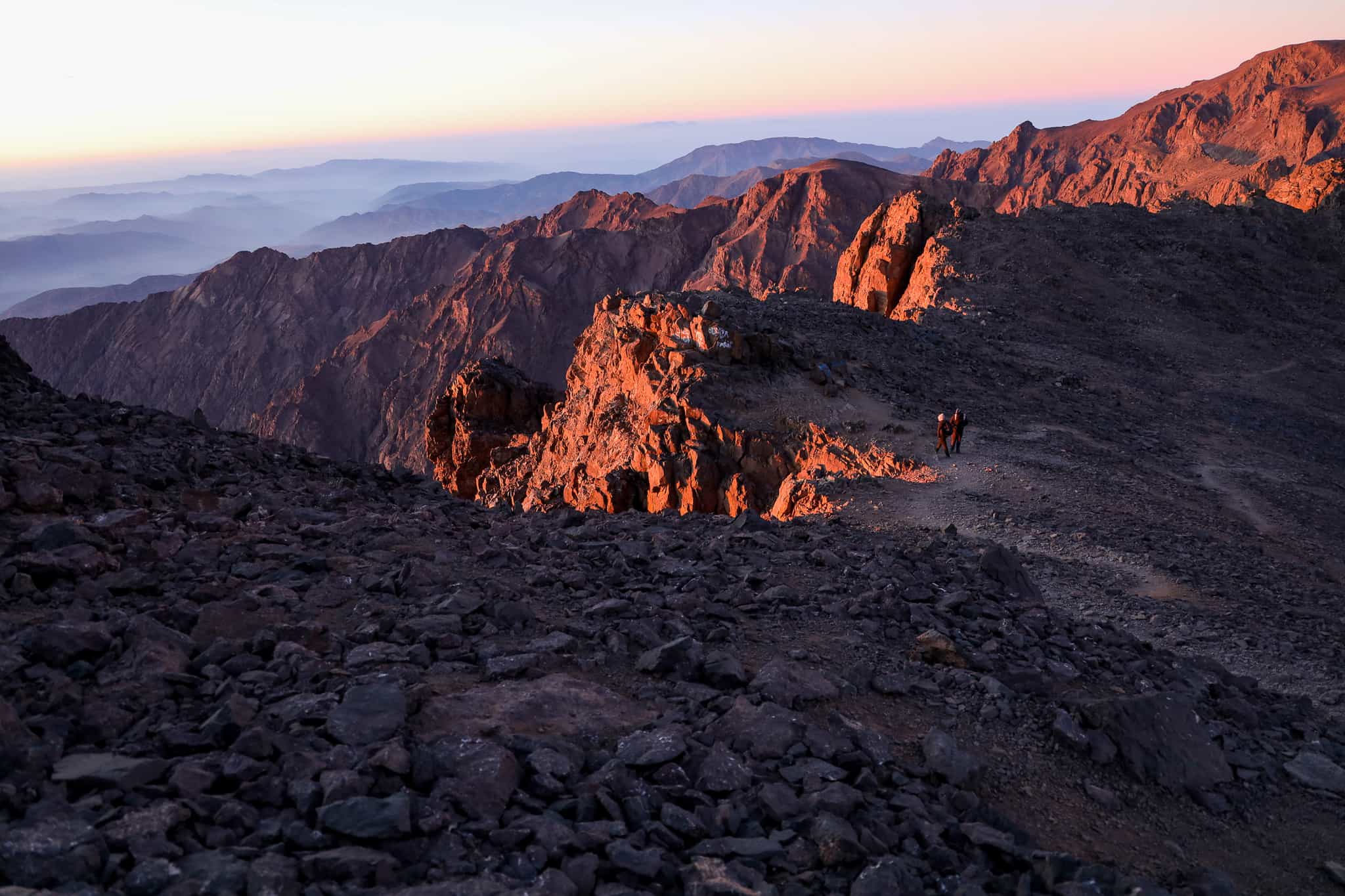
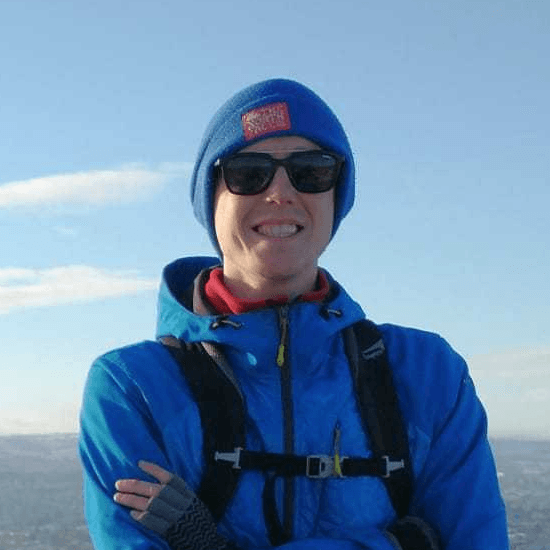
Need help finding flights?
From logistics and how to get there, to fitness, group dynamic and trip difficulty, Rory and his team of friendly experts are on hand to help.
We've got your back
Guaranteed to run
All Much Better Adventures trips are now guaranteed to run. Once you’ve booked your spot you can immediately make your travel arrangements, no uncertainty, no hanging about (excludes 'request to book' departures). Full details
Flexible payments
Secure your spot with the minimum deposit and pay off the remaining balance in as many instalments as you like, with no interest or fees. Full details
Happiness Guarantee
We’re so confident you’ll have an amazing time we’ll put our money on it. Full details
Full financial protection
To give you complete peace of mind Much Better Adventures is backed by ABTOT, ABTA and ATOL memberships. Full details
Tried & Trusted
Much Better Adventures is rated ‘Excellent’ on Trustpilot with over 1000 verified trip reviews averaging 4.8/5.
Connect before you go
You'll be invited to join a WhatsApp group to get to know each other before your big adventure together. Full details
DEPARTURE DATES
Saturday 27th September 2025
to Wednesday 15th October 2025
